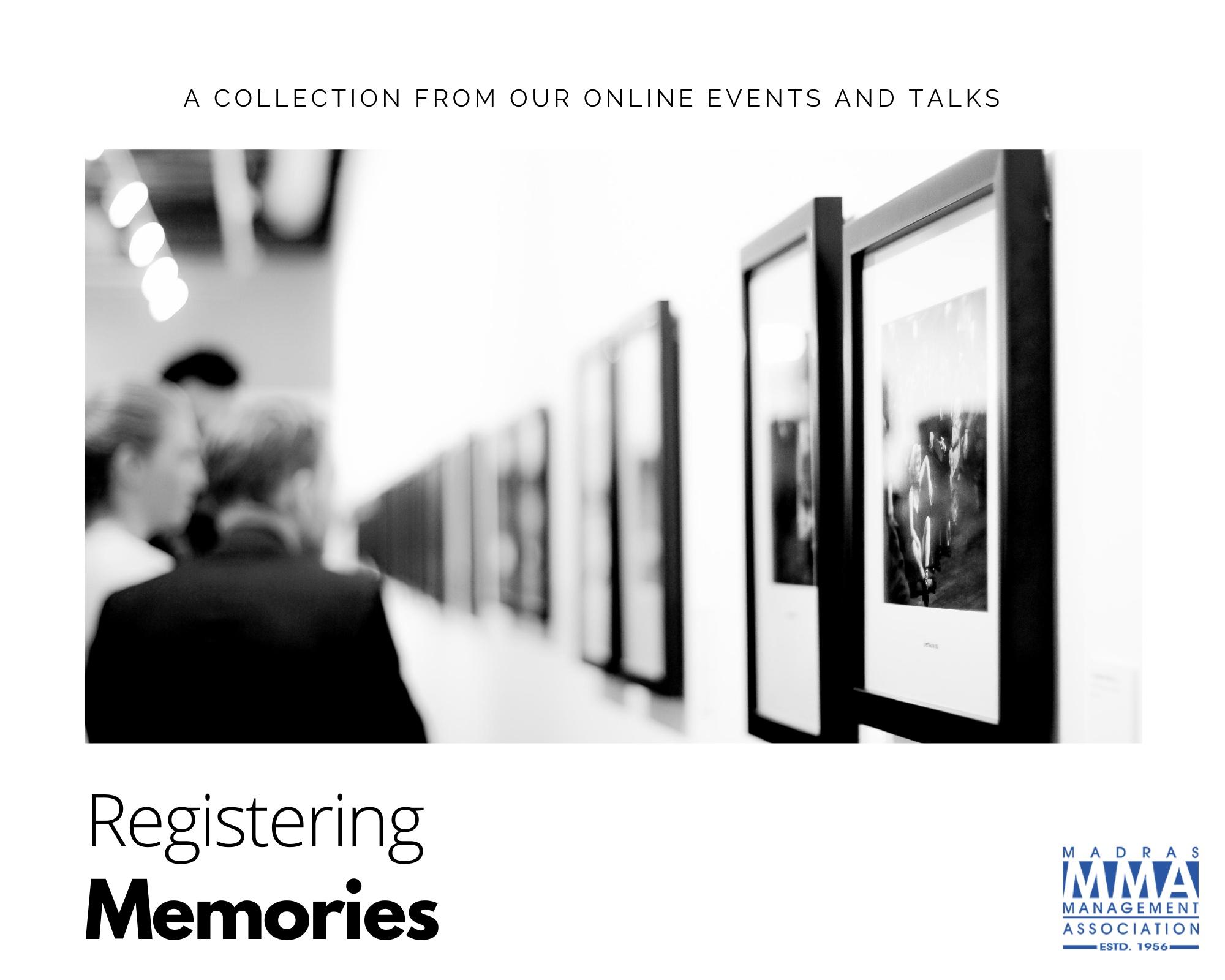
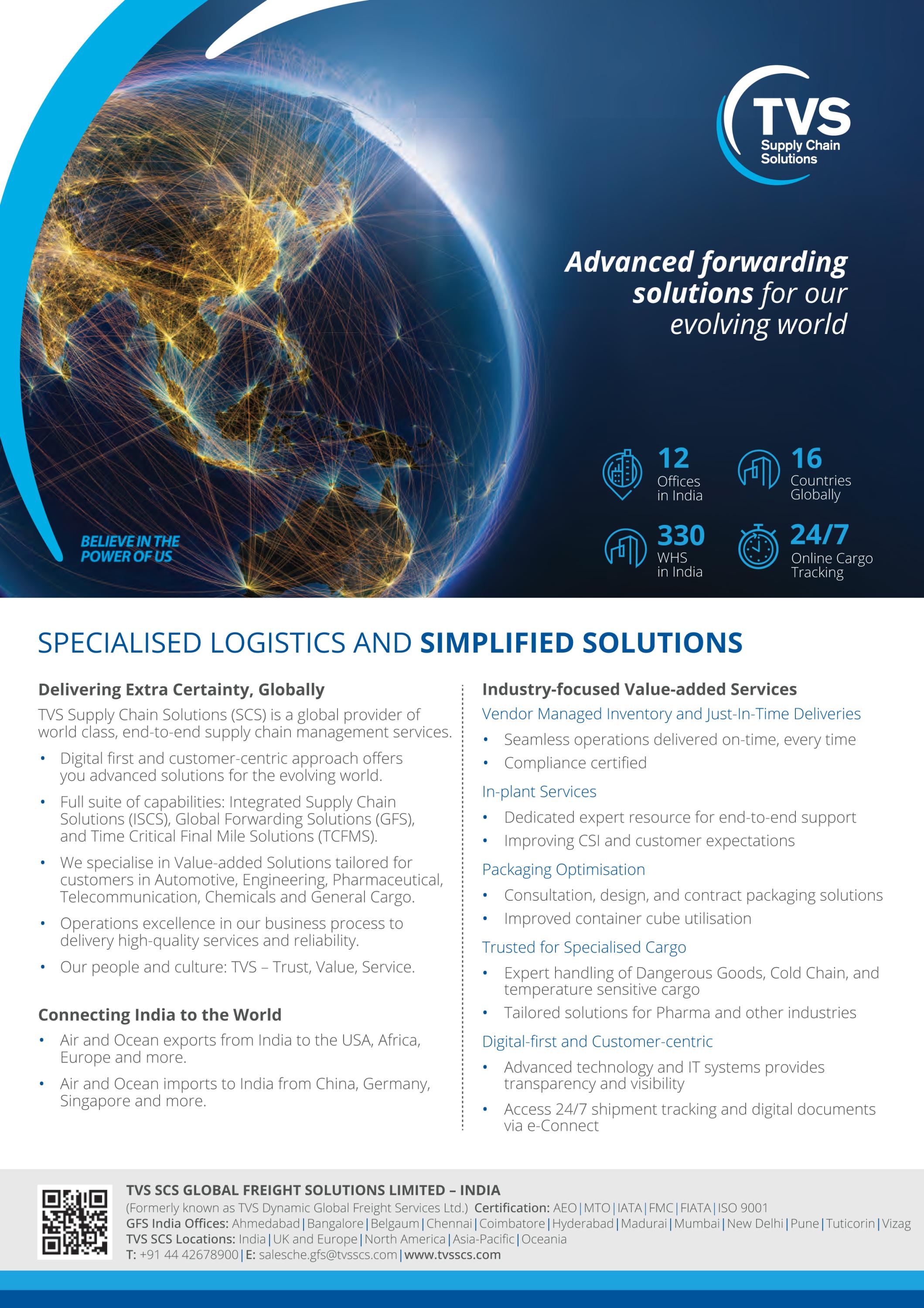





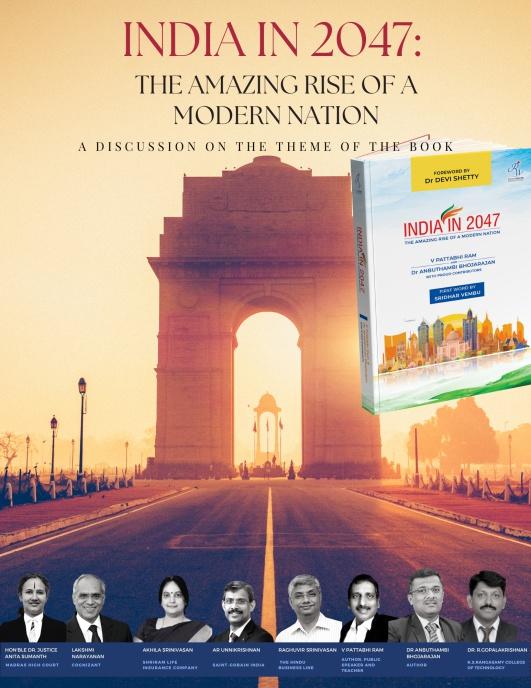

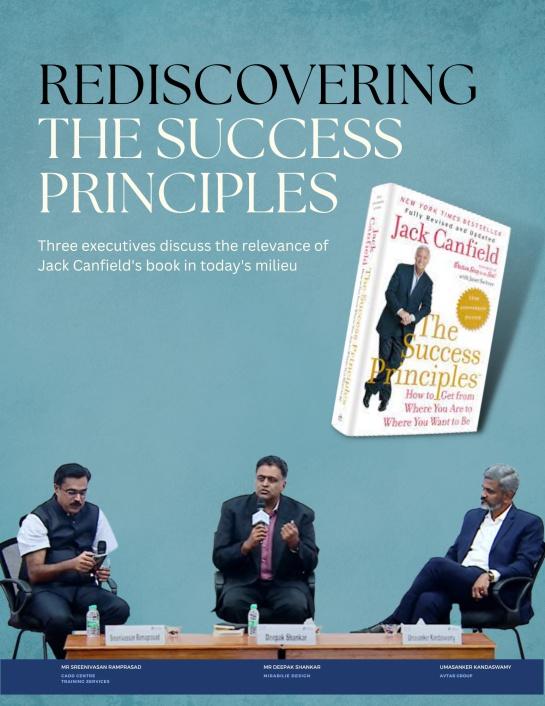
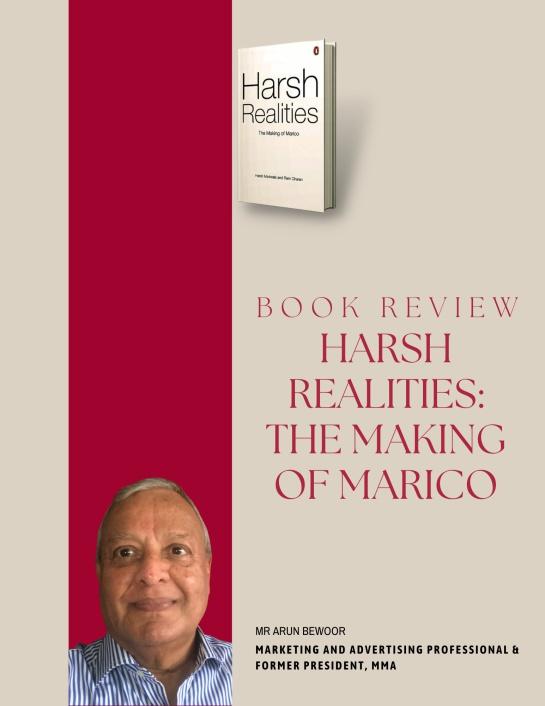














Lofty notions of leadership captivate our collective imagination, but everyday management skills that organisations desperately need remain unappreciated and ignored. In most organizations, leaders are better at assigning work than stopping unimportant tasks Stopping a project or task after investing heavily in it requires courage. However, many leaders dread the resulting adverse impact and end up failing to take corrective actions, which would have enabled employees to stay efficient and agile. This fear of action, or inaction, obstructs any hopes of clarity, stability and safety for employees, and shapes employees’ negative perceptions, resulting in dissatisfaction, lack of commitment and lackadaisical efforts. Good leaders work hard to create fair processes and hold people accountable
Despite the massive attention given to inspirational
Good leadership requires guts, grit and a lot of practice. It is crucial to know how people feel about their organisation, performance and focus.
aspects of leadership, it is clear that most people aren’t still inspired, engaged or truly committed in their work. Good leadership requires guts, grit and a lot of practice. It is crucial to know how people feel about their organisation, performance and focus Let’s stop pretending that it’s a lesser skill set. We need to get serious about building it. In this context, MMA in association with the Andhra Chamber of Commerce
(ACC) organised a presentation by Mr D Shiva Kumar, Group Executive President Corporate, Strategy & Business Development, Aditya Birla Group, on the theme, “On Changing Leadership Expectations” on 18th November 2022, commemorating the 100th joint event between MMA and ACC. Please read on and watch the video for the full talk.
A core component of India’s foreign policy, the neighbourhood first policy focusses on maintaining peaceful relations and fostering collaborative development with the South Asian neighbours and region. However, it is essential for these countries to be mindful of India’s concerns and sensibilities on security, economy and prosperity Now, with its responsibility on assuming the G20 leadership position, India must walk the talk and build capacities to strengthen its position.
In this context, MMA organized a discussion on the theme, “India’s Neighbourhood First Policy,” which focussed on various issues confronting the country and its seven neighbours. I am delighted to present you the thought provoking insights shared by the distinguished panellists on this issue. Please read on and watch the video.
The collapse of cryptocurrency exchange, FTX, at the beginning of November 2022 has a detrimental impact on numerous industry players Unfortunately, fraud has always had a negative impact on finance Indian start ups involved in crypto assets management have said that they have systems and protocols in place to ensure that no FTX like situation arises with their users But the founders and boards must also ensure that these companies follow good governance and due
diligence practices with appropriate internal checks and cross checks, and report through regulatory filings It is imperative that a robust risk management mechanism should be in place, especially till crypto becomes a formal part of the economy. Creating awareness and putting in place an extra layer of oversight over crypto companies make sense and are in the interest of users.
The world has hit a population milestone: 8 billion! India is all set to become the world’s most populous country in 2023 much before 2027, as had been predicted by the United Nation Population Division India is poised to gain a significant number of working age individuals in the next 25 years, almost every fifth in the world Nonetheless, given the country’s existing labour market scenario, one wonders whether such a huge potential of human resources will really do much for the Indian economy unless, of course, we are able to enhance women’s participation on a significant scale The country’s demographic dividend will be wasted if women stay out of the labour market. To be proactive against failures, gender differentials in access to education and skill development must be removed on a priority basis. It is also important to foster the social infrastructure to relieve women from their double
To be proactive against failures, gender differentials in access to education and skill development must be removed on a priority basis.
burden of work and foster a “women friendly” work culture
In this context, MMA Women Business Forum organised a thought provoking talk on the theme “How Gender Equality Benefits Men” by Ms Anuradha Mathur. The article on this event is published in this issue Please read on and watch the video. Don’t let a gender imbalance drag our economy down.

Nearly 190 countries agreed to the creation of a new fund to support developing countries on loss and damage (L&D) arising due to climate impacts This decision was welcomed by governments and civil societies. But is this really a win for developing countries? Who is going to contribute to the fund? It’s my view that a small win was offered to the developing world to show that COP 27 was a success The debate on L&D has entered the most contentious phase and India, on its part, has to ensure that its interest is protected and the developing countries’ bloc continues to be united.
India’s first private space mission, Prarambh, by Skyroot Aerospace, based in Hyderabad, was a grand success. India is still at a very early stage in commercializing its space ambitions Only Agnikul Cosmos, Pixxel and Skyroot have received funding We had the privilege of hosting the Agnikul story at MMA Management Center with very inspiring insights shared by Mr Srinath Ravichandran, Co Founder and CEO, Agnikul Cosmos While Indian start ups are still largely at the pre commercial stage, they expect larger funding post success of the first mission.
MMA under its CSR initiative supported by ACSYS
Investments Pvt Ltd introduced an 8 week workshop “Space Connect” for the benefit of poor students studying at government aided Schools. The objective was to introduce students to various aspects connected with Space Science and Satellite which would kindle their interest in space and rocket science.
I am also delighted to present interesting articles in this issue covering the entrepreneurial journey of Mr Muthu, CEO, Idhayam Oil, a story on Mr Harsh Mariwala, Chairman, Marico Ltd and India 2047 and more .
Please read on and get inspired.
As always, we would be happy to hear your views, comments and suggestions
Merry Christmas and happy reading!
Nearly 190 countries agreed to the creation of a new fund to support developing countries on loss and damage ﴾L&D﴿ arising due to climate impacts. This decision was welcomed by governments and civil societies. But is this really a win for developing countries?
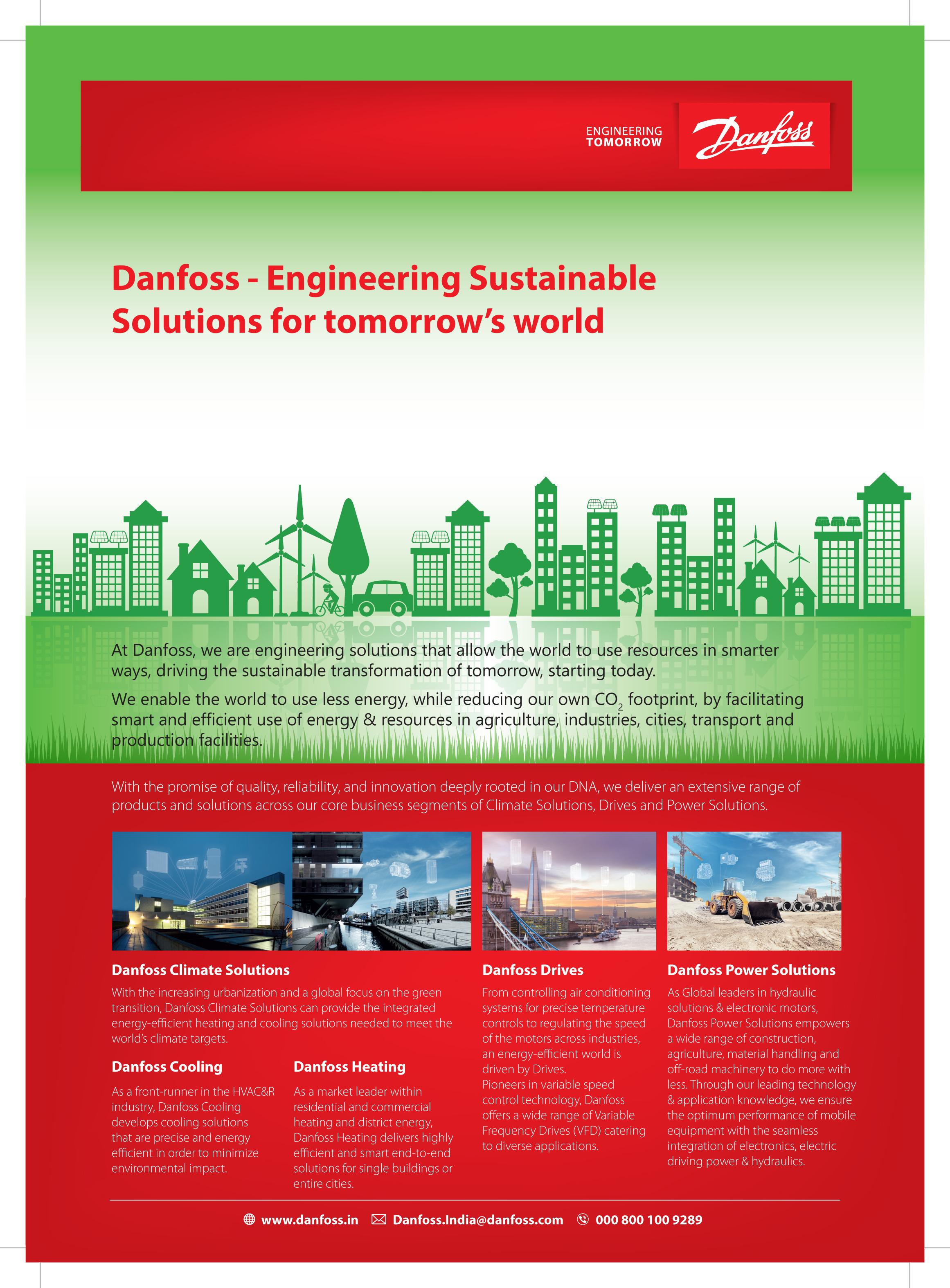
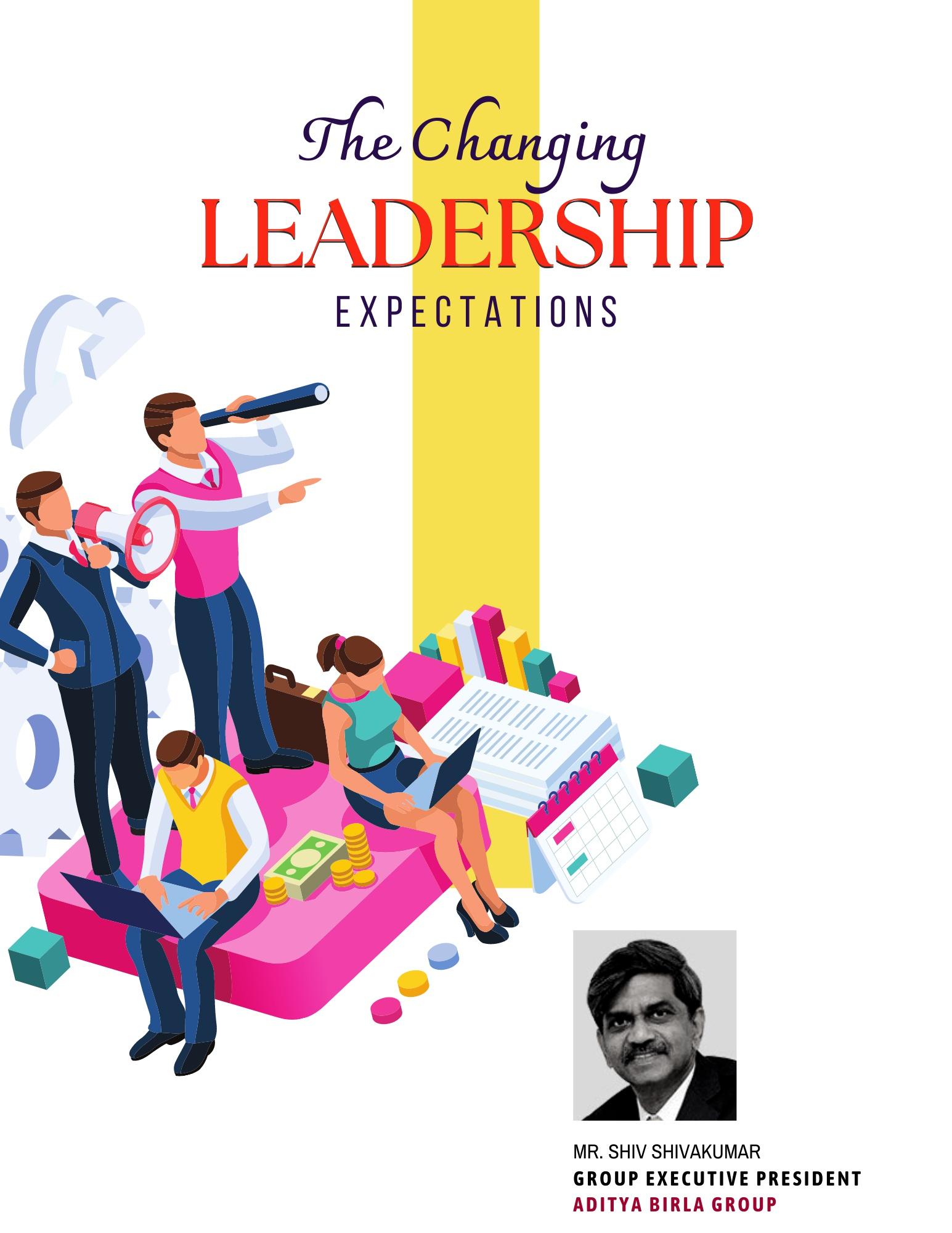
Commemorating the 100th joint lecture series of MMA and Andhra Chamber of Commerce, Mr D Shivakumar, Group Executive President, Aditya Birla Group, gave a presentation on how leadership expectations are changing fast and how it is impacting our lives
Astaggering amount of change has taken place in the world. It's only when you step back and look at it that you realise how much the world has changed Let me take you through the last hundred years and how things have changed. Post World War II, America became the dominant power; reconstruction of Japan started; The World Bank came into being; and Europe was being reorganized Government played a key role in rebuilding the economy. One could not do anything in the world without the government. Leadership then revolved around military strategy and generals, and politics was about the ‘great man’ theory and a rules based world order.
The 1950s were industrialists’ era. The model of leadership was around what the industrialists were doing We learnt from them In the 1960s, the world saw the hardware era. We had the supercomputer and IBM System/360 mainframe computers. In the 1970s, we saw the start of global branding Nescafe and Coco Cola were one of the first few brands to go global The 1990s witnessed globalization, thanks to the rise of
China as an absolute manufacturing powerhouse We got cheap products, well below the inflation rates in most countries. The 2000s saw mobile phones coming through I was involved with mobiles for close to a decade. In 2005 06, when I started in Nokia, there were just 90 million subscribers in India. When we said we'll connect the 90 million to the 900 million who were not connected, everybody laughed at us Today, all of us have mobile phones. The digital era started.
We
and binge eating. People stack up for the weekend four or five web series and watch them non‐stop. Till you recognise that something of the past is dead, you will not change as a leader.
only thought of binge drinking
The current era, from 2020, is the platform era. It is about disruptive ideas. Each of these eras had a lesson for leadership Till about five years ago, our leaders communicated their thoughts to the outside world through media and journalists but not anymore. They now communicate through social media. There are 600,000 journalists in the world today, and 3 2 to 38 million influencers in the world They trust influencers. Today’s leaders do not need journalists. They have their own vehicle. Elon Musk is communicating his strategy for Twitter through tweets The Wall Street Journal and economists are reading all his tweets, figuring out what he wants to say and do. Media has become more of a reflective commentary All breaking news is on social media That's the first big and dramatic change for leaders.
In society, we see visible changes everywhere with every new thing that arises, something else dies. Journalists are dying because of influencers. The mobile phone brought the death of the disposable camera The
leadership has to recognise that they have to kill or give away some of the skills they had in the past. Thirty years ago, dictation was a big skill for leaders; a leader dictated notes to the secretary. Today, nobody does that. Short hand was a big skill for leaders’ assistants. Now short hand is there but there are no assistants Selfies are the death of autographs I was in Australia for the T20 World Cup semi finals and finals. Everywhere I went, nobody was taking an autograph.
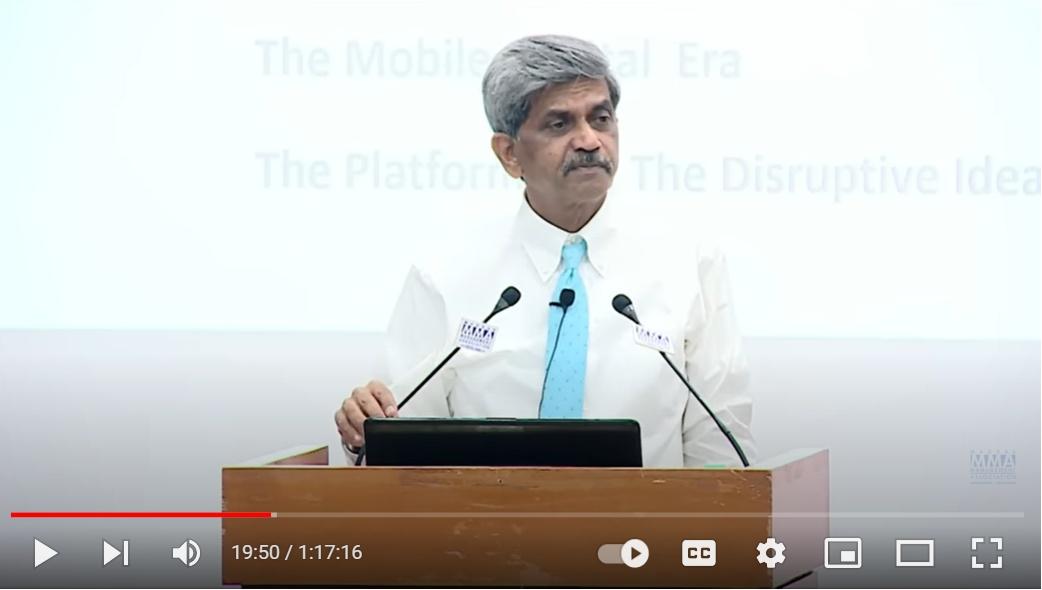
Today’s leaders do not need journalists. They have their own vehicle. Elon Musk is communicating his strategy for Twitter through tweets.
On the boundary line, people called the player and took selfies That's the new norm. OTT is the death of sleep, thanks to binge watching. We only thought of binge drinking and binge eating People stack up for the weekend four or five web series and watch them non stop. Till you recognise that something of the past is dead, you will not change as a leader.
Look at the most valuable Top 10 companies of 2012 and the most valuable Top 10 companies of 2022. How things have changed in 10 years!
In 2012, Apple was the most valuable company in the world at $559 billion followed by Exxon at $409 billion, Petro China at $278 billion and Microsoft at $270 billion In 10 years’ time, only three out of those ten companies are on the list. In 2022, Apple continues to be number one at $2.4 trillion. Its market value multiplied four times Saudi Aramco is now at No 2 at $1 9 trillion followed by Microsoft at $1.8 trillion, Google $1.3 trillion and Amazon $1 trillion. Exxon Mobil is still on the list and its value has increased from $409 to $470 billion Tech companies now dominate the list.
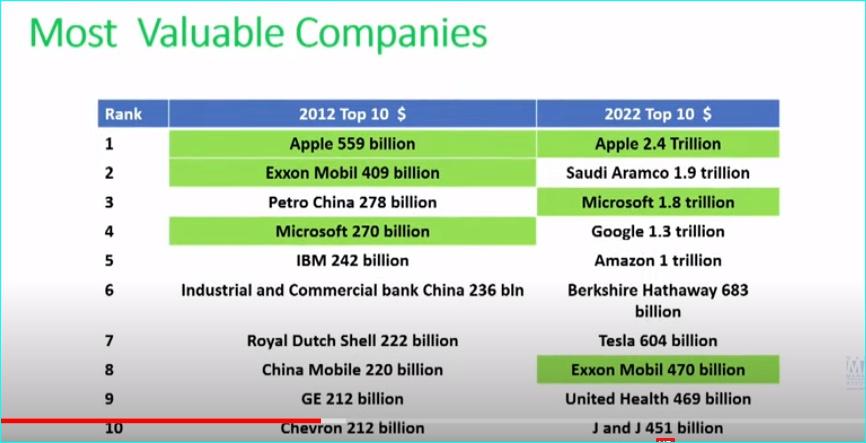
Let's look at the most valuable Top 10 Brands of 2012 and 2022. Only six brands have lasted from year 2012 to 2022. In 2012, Coca Cola was the number one brand with a brand value of $78 billion, followed by Apple, IBM, Google, Microsoft, GE, McDonalds, Intel, Samsung and Toyota. In 2022, Apple is the number one brand at $482 billion. Its market value has gone up by
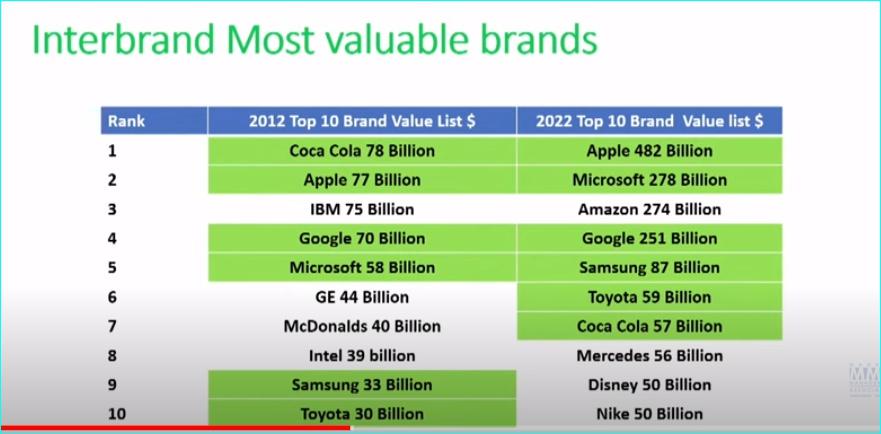
about six times No 2 is Microsoft Its value is $278 billion, up by about five times No 3 is Amazon It wasn't on the list in 2012. No 4 is Google, up 3.5 times from $70 to $251. Samsung has gone up 2.5 times, from $33 to $87 Toyota has gone up from $30 to $59 Coca Cola is still on the list but its market value has gone down from $78 to $57. Coke used to be the number one brand for 10 to 15 years It has gone down because people now want to be healthy Six of the Top 10 brands of 2022 are Tech brands. So whether it's the most valuable company list or the most valuable brands list, it is technology which dominates and not traditional manufacturing industries
What types of companies we had about sixty years ago? We had the military, government companies, private companies and family companies. Today, we have multinationals, family companies, private equities and venture capitalists (PEs/VCs), NGOs, Government

companies, SPAC and startups The leadership, which was confined to the military, government, family and private is now a much broader spread. Startup leadership is as much celebrated as MNC or private enterprise leadership There are more avenues for leadership to grow and the dimensions of leadership in each of these areas are very different.
So, what are the changing leadership expectations and how does one look at it? Leadership development is a four billion dollar business. However, 50 to 60 percent of leaders don't meet the targets in the first 18 months despite the industry doing well The average tenure of a CEO is five years, and in India, it is four years. Gone are the days when you had a CEO with 15 years’ tenure. Recently, the government has announced that the tenure of the head of public sector banks has to be minimum 10 years But overall, the CEO’s tenure is shrinking. It’s about maximising in the short term trying to do everything right in 3 or 4 years’ time and getting out before anything goes wrong
Everybody talks about the VUCA world volatile, uncertain, complex and ambiguous. My definition for VUCA for leadership is Versatility, Uncomfortable (Being uncomfortable in comfortable times), Collaboration and Agility.
#1: Leaders must lead and change, not react In the past, you had reaction time. Today, it’s not there. They must be prescient to say what will happen in the future. They have to guess and put into play some mechanism, so they can win
#2: A leader has to be a ‘knowledge sponge.’ A sponge keeps absorbing water. The amount of information out there is dramatic You have to keep soaking in information In the past, just knowing the industry
The whole motor industry was looking at each other... But who came along and disrupted?
Tesla.
information was good enough Today, you need to know more than that because competition can come from anywhere. The competitor to a bank may not be another bank. It may be UPI. We now do banking through netbanking, ATMs or mobile banking Today's competitor will not be a competitor tomorrow. The whole motor industry was looking at each other Volkswagen looking at Toyota, Toyota at General Motors and General Motors at Ford But who came along and disrupted? Tesla.
Look at the two wheeler market. Where are the EVs coming from? They are not coming from the current players but completely new guys like Ola and all kinds of new people. Once you gather the knowledge, you need to put out the insights for your people in the industry
#3: Develop people, though you have a short term It is the qualitative thing. Develop them through meetings, coaching, the way you conduct yourself and the questions you ask than the answers, you provide The best leaders ask a lot of questions The ability to develop people is a very big expectation today. All young people who join an organization want to work for a boss for two years and learn as much as the boss knew from 20 years.
#4: Build relationships. The days of independent growth are over. You are dependent on somebody else. So, build relationships with government, society, competitors, media and industry people with everybody in the ecosystem. The industrial era was
f o u n t a i n h e a d o f e x c
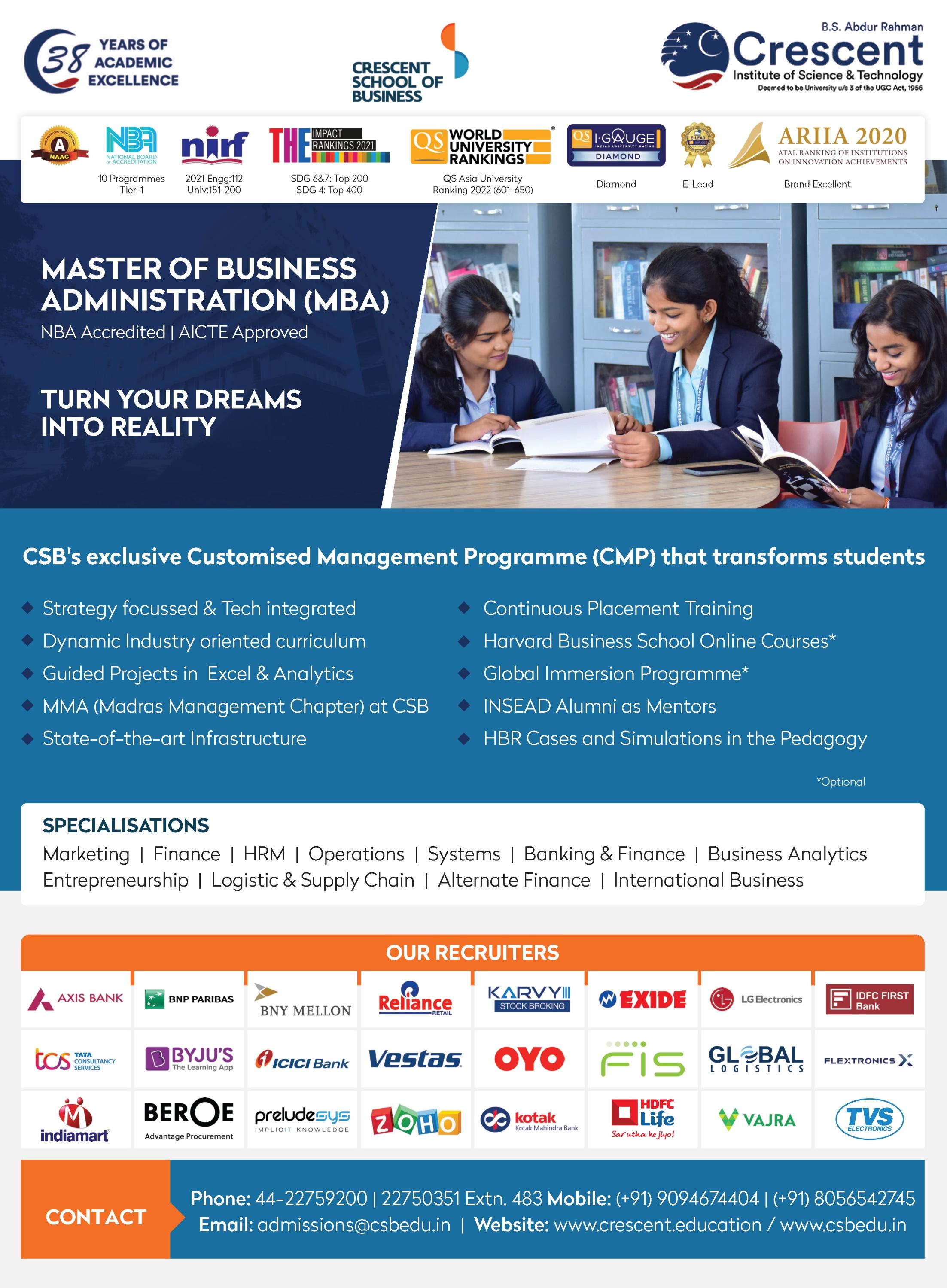
based on getting licenses. Once you got your license, you could build a relationship with anybody That's not true now Today, you have to build relationships with everybody in your ecosystem.
#5: Be accountable. If anything goes wrong in your company, you have to stand up and say, ‘I am accountable ’ Look at all the layoffs happening in India Every CEO says ‘I'm accountable,’ and ‘I’m sorry.’ But people ask, “What did you do about it? The leader must ask, “Why did I expand when I didn't need to?”
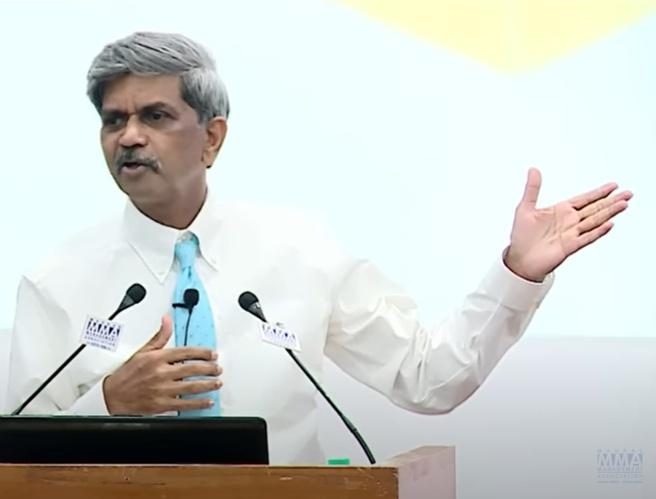
#6: The leader must have high self awareness Unfortunately, when you are a leader, nobody tells you the truth. It's only through multi source feedback; by talking to 20 or 30 people; and by talking to competition, you can know the truth.
#7: Leaders must inspire. It may be through personal work, habits and behaviour. Inspiration does not come from lofty speeches It must come from lofty ideals and walking the talk.
#8: Communicate using different platforms. Today’s leaders must remain on email, Twitter, LinkedIn as many modes of communication as possible They have to be 24 by 7 with the team. Whether people listen or not it is a different matter but that's what they expect from their leaders When you have a web call, half the
guys don't switch on their cameras You hope that somebody is listening to you
#9: There's no place for complacency. You have to be accountable. You cannot postpone even for a minute something which you can do right now
Most of these are soft skills Leadership is no longer about hard skills, which are a given now. It is expected that leaders must know about strategy, Porter’s 5 Forces Model, etc The hard part is the soft aspects of leadership, where most leaders get challenged and fail
#10: Be REAL. For leaders to be successful, they need to be REAL, which is my acronym for Relevance, Excellence, Authentic and Luck Leaders have to be relevant Remember the birth of something new is the death of something old. Social media is here to stay and leaders have to be on social media and relevant for today’s context They have to excellent and cannot be substandard. Authentic does not mean being nice to people. It means being consistent and true to who you are Being authentic means sticking to a few values and communicating them consistently all the time You can only do that, if you put in the best work. You need a lot of luck to be a leader today. As the world shortens, you must have luck by your side You might do all the right things and still fail So you need that L called Luck.
The hard part is the soft aspects of leadership, where most leaders get challenged and fail.
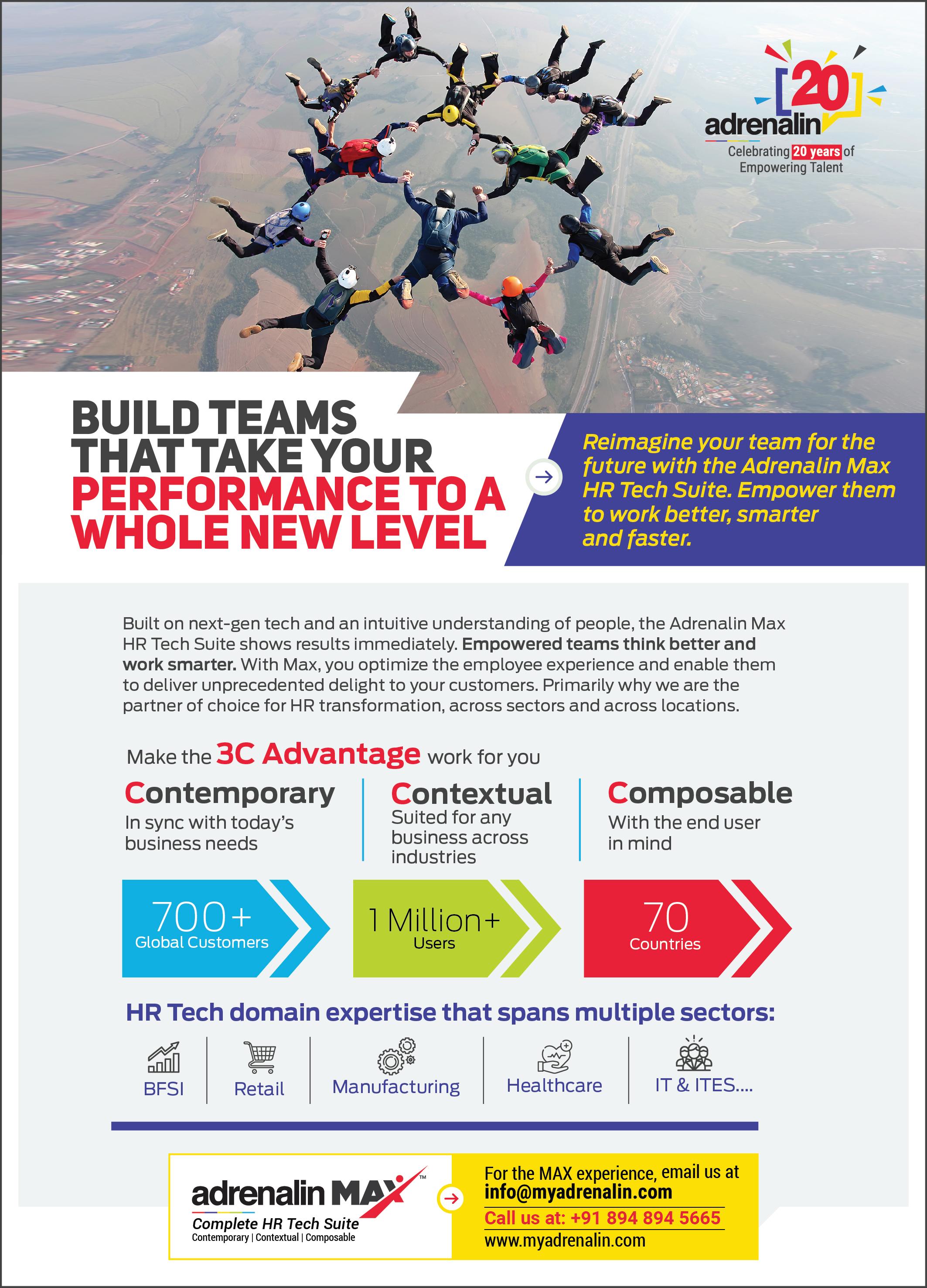

The biggest problem for leaders today is success traps They have been successful in the past with a particular formula and try to repeat it. The only industry it might work is in government controlled organisations It may not work in a world which is disruptive So watch out for success traps. In organizations, it is tough to retain leaders beyond five years. So, don’t we need collaborative leadership?
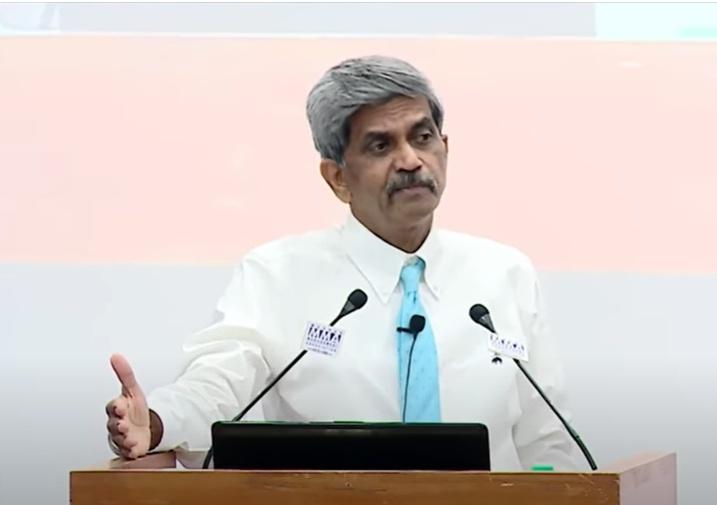
Collaboration is just not for the rank and file. It must be across the line. There is no substitute to collaboration You need to collaborate with people outside the organization. For example, I have good friends in many of my competitor firms. As an industry body, you have some common items to deal with like GST, etc. You must collaborate on a few things as leaders. You have to compete in the consumer’s mind Between competitors, you
don't need to punch each other. People say that luck favours those who help themselves. What do you say on that?
I agree to it For leaders who consistently follow the process and prepare themselves for the future, luck comes knocking on their door. You need to be prepared for luck to favour you. What kind of challenges will the leaders face now?
The biggest challenge for leaders will be the ‘time capsule’ condensation. More and more have to be done in lesser and lesser time When I started my career as a CEO, I could take a week or two to gather all the information, assimilate it and come back with an answer Today, the team comes to you, briefs on what is happening and needs an answer in the evening. Second, the amount of things you need to cram in your head which is 10 times more than what it was ten years ago Third, you need to communicate very well. If you cannot communicate today as a leader, people write
you off It is sad but true You must be a very good speaker and communicator For example, Obama is a great speaker. When Obama’s speech writer went to the UK, a UK leader asked him to give suggestions on how to speak like Obama You cannot be another Obama You have to be articulate. You must be able to synthesize everything in your head and put it down in a simple manner for people to understand Staying relevant is another big challenge.
How can one handle pressure as a MBA graduate or an upcoming entrepreneur?
Everything in life will have pressure, whether you're doing MBA, BE or B Tech or running a hundred core company or sourcing capital or technology. Sometimes it is self induced and sometimes it's not. If we are pessimists, we invite pressure ourselves Some are optimists and don't take pressure when they should actually be taking some pressure. Both ends of the spectrum are wrong To handle pressure, first you must be healthy by exercising, eating right and having right habits. When you are a leader, you must have energy and focus
What are the personal habits that we have to change as leaders to have work-life balance?
Work life integration is a deeply personal thing. It is entirely up to you. How you use the 24 hours a day is in your hand If you spend 18 hours at work, then you have to recognize that the six hours you spend in the family is short. Sometimes you need to give your family more time; sometimes you need to give your work more time because both family and work will throw crises and challenges. No boss or company can give you work life integration. It's
yours If you don't like the company and your boss, it’s better to leave it That's all
Why do we see the great resignation today?
In the pandemic, a lot of people sat at home and started introspecting, “What am I doing with my life?” There's mass resignation and demand for work from home. As long as the individual is talented, he or she is the king. Talent is at a premium today Going back to the REAL acronym, you need to be relevant and be the best in your job. Then if one door shuts, three days will open for you. Remember, the company is no longer accountable to you for anything You are accountable to yourself and your family for everything that happens. It's all on your plate.
What is the strategy that Apple followed to stay on top?
Apple was very strong in desktop Then they came with iPhone and iOS and built a beautiful world around it with all the apps. Over the last 20 years, they have been consistently innovative and looked at the product and service as an extension and not just as the product. That's the biggest thing they have done right They focused on design and user interface The products are simple.
With things like moonlighting, frequent job hopping and demand for WFH, what is expected of leaders?
I tell my teams, “Look, this is the company policy I cannot change it ” As an example, if the policy says there's no work from home, I have to stick to it. I always tell them, “Do what is right for the institution or the company Then, you'll always win If you put yourself out of the institution, it's unlikely that you'll win in the
long term ” I also tell them to work well with other people Unfortunately, due to shortening life cycles, there's a lot of jealousy and pettiness at work today. I tell all the teams, 'Don't indulge in that ”
You are the President of Mobile Marketing Association. Can you share the current status of 5G rollout and why there is a delay in it?
5G is here to stay The 5G licenses have happened. One of the companies has committed 13 to 15 billion dollars of investment on 5G and the second company has committed four to five billion dollars The latency and speed with 5G will be amazing. You can download a three hour movie in under a minute. Metaverse will happen and everybody will go around with glasses and see the world in 3D. 5G's impact will be dramatic. We went to one of the labs of Microsoft and could see a doctor in Bangalore operating on a patient and on his shoulder was sitting a doctor in Mysore on Metaverse, guiding him on the surgery. Assisted learning and assisted guidance will be one of the biggest things in metaverse All of shopping which we do in two dimensional now will happen in 3D. You can wear the glasses, pick an apple in a store, check it and buy, all these sitting in your home. 5G’s impact will be phenomenal. Right now, I think, 70 countries in the world have 5G.
To roll it out, it takes times as you need to build equipment and a whole ecosystem behind it It doesn't happen overnight.
You spoke about lot of jealousy in workplace. Not much training seems to happen now in Organisational Behaviour. Should corporates focus on this area?
Now, on the job training has died Companies don’t want to invest in employees
f o u n t a i n h e a d o f e x c
as they leave in two or three years Second, bosses are very insecure and they fear their subordinates will overtake them. There are a number of reasons why this happens but as leaders, we have lost the ability to train people on the job. Each of us, as leaders, must do that. Has spirituality got anything to do with success?
Yes IKIGAI, the Japanese term is about purpose. One of the things is about spirituality. Many people say that spiritualism is the route to rid oneself of pressure There are many different thought processes, but I think ultimately, it's down to the individual. You must be comfortable at what you're doing. There are some people who are hyper and successful, who don't take pressure There are people who are very calm and serene but don't deliver. There is no one formula for any one individual, but I see the growth of yoga, ayurveda, organic and naturals. I can see that people are trying to reach out and touch the roots from where they came So spiritualism is a big movement Whether it is the answer, I don't know But definitely, it's on the rise.
What is your advice on the habit of reading?
It depends on your learning style Some people read books and learn. Some people learn by working in project groups. Some try experiments, fail or succeed and learn You have to figure out what's the best learning style that you are comfortable with. Then stay with it. For me, it is learning from a book reading. I read many articles, look at the information and see if a trend exists. That has worked for me all my life and that's why I tend to read a lot.
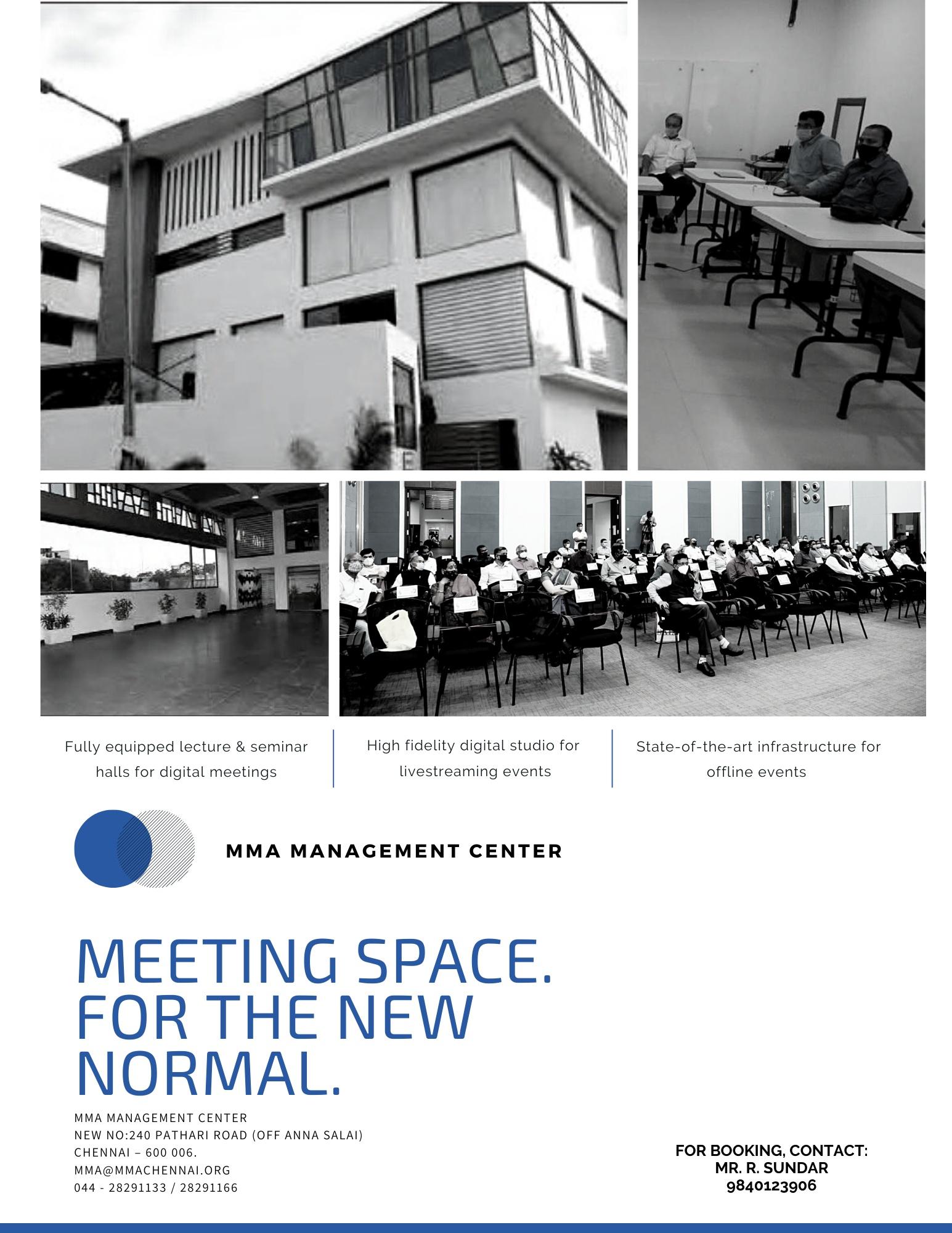
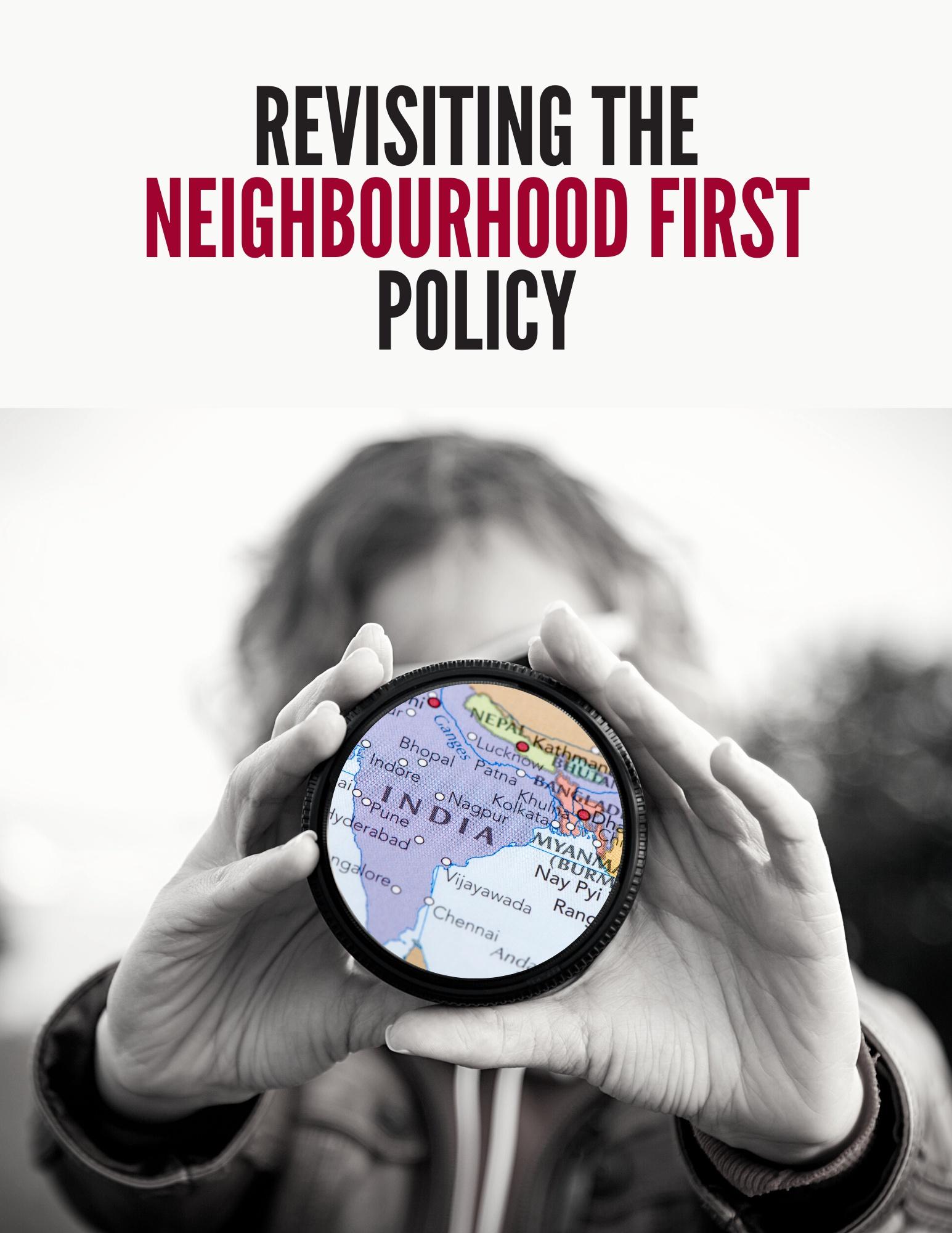
Our border states are stakeholders in our neighbourhood policy.
At a time when the rest of the world, starting with the UN, has been hailing India’s ‘Neighbourhood First Policy’ , it may be time for New Delhi to move forward, after revisiting the ground realities and strengthening the processes periodically, to make it work continuously
Suba Chandran Professor National Institute of Advanced Studies
There are four hypotheses to our neighbourhood first policy:
• India doesn’t have a natural neighbour that will help us achieve our objectives.
• India is not strong enough to change others, nor weak enough to be changed by others.
• International actors both influence and undermine our neighbourhood policy they undermine more than they influence
• Because of these three factors, India’s neighbourhood policy progress card is below par and we have not had spectacular success
When we look at our geographic neighbours, we can see that our neighbourhood is not stable. Take, for example, Nepal, Pakistan, Afghanistan and Maldives. We need stable neighbours We don’t have a trading neighbourhood like the ASEAN, EU or African Union. Our trade with SAARC countries is less than 4% of our trade Though we have invested substantially in Afghanistan, not much trade is happening there Trade gives us a constituency. We don’t have it significantly with our neighbours. We don’t have friendly neighbours too What we have is a conflictual relationship with our neighbours We have proxy neighbours Pakistan was acting as a proxy to the US and now China is playing the role of the US.We don’t have deep pockets. Even with shallow pockets, could we have done better is a question we need to ask. Could our political approach have been better to achieve what we want to achieve in the neighbourhood? To hold dialogue or not with Pakistan has been a dilemma for a long time Of course,
the present government is clear that there is not much of a positivity in this dialogue and we are clear in what we want to do with Pakistan
We put all our eggs in the Afghan basket when Hamid Karzai and Ashraf Ghani were in power. Perhaps we focussed much on the erstwhile Northern Alliance When our friendly people go out of power, we face problems. Let's see how it goes in Bangladesh. When we talk about neighbourhood first, are we looking at our neighbourhood as an end game or as a pivot to another region? Are we looking at Afghanistan, Pakistan and Bangladesh, Myanmar as an end in itself or to reach out to the larger region? There is nothing wrong in thinking in terms of our immediate neighbourhood and extended neighbourhood. Bangladesh and Myanmar are the gateway to South East Asia; and Pakistan and Bangladesh are gateway to West Asia
We don’t strengthen our arms to deal with our neighbours. Our border states are stakeholders in our neighbourhood policy. For example, we can include
West Bengal to strengthen our case with our north east and Bangladesh; Chennai to strengthen our case with Colombo; and Punjab and J&K to deal with Pakistan
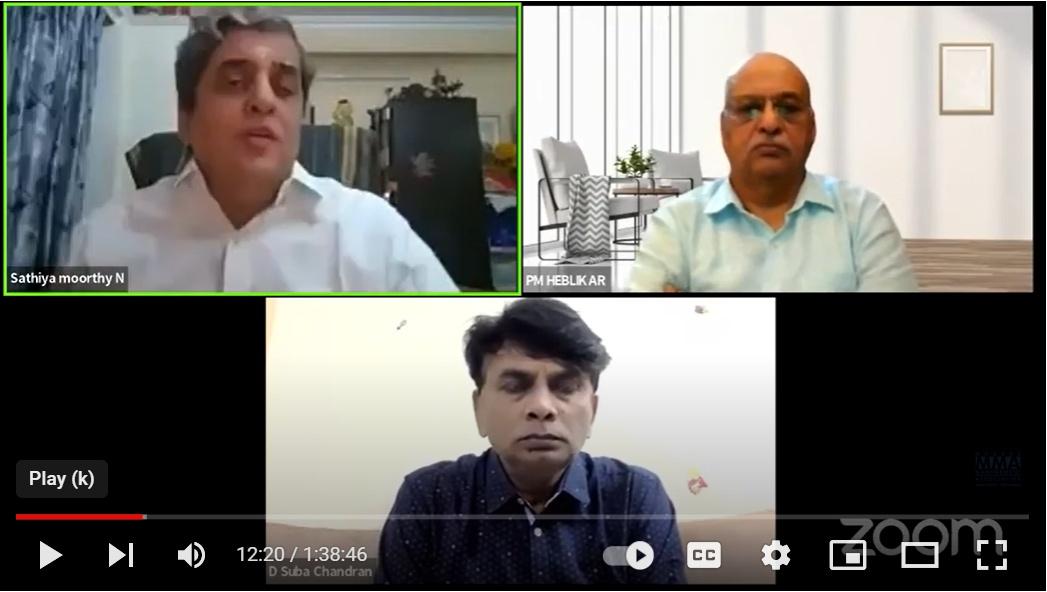
Such an approach in which we give more power or elbow room to our own periphery, can result in more of cross border trade India must look at transactional relationship with our neighbours and there is nothing wrong in this approach.
The way we are moving from SAARC to BIMSTEC seems to suggest that we are trying to redefine our neighbourhood because of our frustrations with
The way we are moving from SAARC to BIMSTEC seems to suggest that we are trying to redefine our neighbourhood because of our frustrations with Pakistan and Afghanistan.
Pakistan and Afghanistan To conclude, there are certain inherent problems, of which India could not do much. These prevent India from playing a larger role in the neighbourhood. At the same time, there are also issues within us that do not help us in our objectives
with the north east has international dimensions The north east region sits in a geographical space which is home nearly to a billion people, comprising the populations of Myanmar, Bangladesh, Bhutan, South West China and Asia Had it been for normal activities, this region could have become a game changer for Asia.
In 2014, the Look East Policy was changed to Act East Policy (AEP). It became India's new vehicle for the region The government also added strategic and military aspects to it, so the AEP has become a strategic vehicle for India. Bangladesh has now become the second most important bridge for India in this region
Mr P M Heblikar Managing Trustee, ICSB & Fmr Special Secretary, Government of India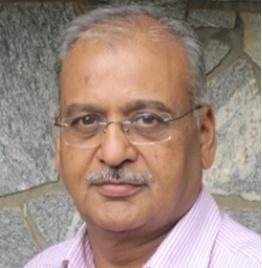
In1991, when Narasimha Rao was the PM, our relations with SE Asia came to the fore He came out with the 'Look East Policy (LEP),' whereby we can reach out to our neighbourhood in ASEAN and beyond the region. He didn't want to invest much in the countries to the west and decided to engage with our neighbours in South East Asia which included countries like Japan, Vietnam, and South Korea. The second reason for his approach was that in 1967, when ASEAN was established, India decided not to join it and missed the bus. He wanted to catch up. That was our starting point in our journey in the north east and South East Asia. The PM then wanted that LEP should become a platform for political, economic and security cooperation
Between 1991 and 2014, the LEP had made some progress in the direction in which it was intended to be Myanmar became the bridge to our connections in the north east In strategic terms, India's connection
In July 2022, our MoS for External Affairs said in Parliament that India had 37 Lines of Credit (LoC) worth 14 Bn dollars covering 162 projects in five neighbouring countries which included Bangladesh, Maldives, Myanmar, Nepal and Sri Lanka He compared this to what India was doing in Africa. We had 222 lines of credit worth 14.07 billion dollars to cover 357 projects in 42 countries in Africa There is clearly the intent that as a free trading economy, we share our developmental assistance with these countries.
India has several other multiple interactions with these neighbouring countries Our PM Modi has made many suggestions in the Fifth BIMSTEC Summit We also have the Mekong Ganga Cooperation (MGC) which deals with Cambodia, Laos, Myanmar, Thailand and
AEP has become a strategic vehicle for India.
My own observation is that some of these neighbouring countries ought to settle down and look at India more as an opportunity than a threat.
Vietnam In 2016, India created a corpus of 500 crores to help these countries, to have access to Indian markets and access to information on India's trade services to these countries. This was operated under the aegis of the Ministry of Commerce in India
As far the north east region is concerned, we are aware that since 1991, it has become less important than South East Asia. However, the Government of India is conscious that it needs to bring greater economic development, safety and stability in the north east The support from Myanmar and Bangladesh is an important factor to achieve this objective and to help us keep the insurgency in the north east under control Having established a semblance of peace in the region, we see a large number of developmental activities taking place for instance, construction of railway lines in Tripura, Manipur and Mizoram It is true that progress has been achieved and it in ongoing. However, we need the cooperation of our neighbouring countries.
My own observation is that some of these neighbouring countries ought to settle down and look at India more as an opportunity than a threat. India does not constitute any threat to the neighbouring countries However, India needs to protect itself from the activities of inimical forces
Myanmar is suffering the after effects of a coup in 2021 when the military ousted a democratic leader The present Head of State believes that he has got people's approbation for his action. However, the opposite has taken place and there is civil war The military is not able to dominate the situation India has shown a calibrated response to the developing situation there and expressed its intent for the democratic process to return to the country India has also appealed to the
international community to talk to the Generals in Myanmar Despite this, India's relationship with Myanmar continues to be stable. Instability on the border will create more problems for both sides. India needs peace in the north east and along the 1600 km north east border with Myanmar. Last year, according to United Nations Commission for Trade, Myanmar's exports to India were 858 million dollars, mostly coming in the form of raw materials Myanmar has been a difficult country, right from 1966, for our diplomatic efforts to fructify. Between 2010 and 2020, when Myanmar had a democratic set up, substantial progress was made
With Bangladesh, from 2009 onwards, our relationship has gone from strength to strength Seven agreements were signed when Sheik Hasina, Prime Minister of Bangladesh, visited India in 2022. This relationship with Bangladesh is very important for India. It has helped us control insurgency in the north east region. But what we need to be wary of, is the revival of fundamentalism in Bangladesh and what it means for the future The developments in India have also had their echo in Bangladesh, with violent incidents taking place there. Our vaccine diplomacy has had a good impact in strengthening our neighbourhood relations The role of G20 and what India brings to its leadership will be significant. It has been supported by India's own credentials in the region. We have made a large contribution to the individual countries in our neighbourhood. However, we need more of private sector interaction.
We need a greater understanding of our neighbours Ignorance of them is also a threat We need to work on capacity building and must focus on what our neighbours do, over and below the radar. To
conclude, our ‘neighbourhood first,’ policy stands on strong foundations and there is no need to revisit it Our policy is young. It requires sustenance. We need to bide our time. We can only follow the US way.
InSri Lanka and Maldives, leaders have not changed in the last 27 years Maybe the governments have changed but the core leadership is the same. Their domestic policy drives their foreign policy. We need to recognise this Pakistan has made India the raison d’etre of its existence In Maldives, there is an open anti India campaign by the opposition. India is becoming a factor there, for no fault of India. There is a perception that India is backing the present Maldives government by funding its development projects. India needs to make its stand a little clear that it is dealing only with the government and not the individual leaders Both in Sri Lanka and Maldives, China was supporting a certain leadership. But in Sri Lanka, people drove that leadership out.
In Sri Lanka, despite a great economic and political turmoil, the political system took over without any great difficulty. There was continuity with change or change with continuity. If economy will survive or
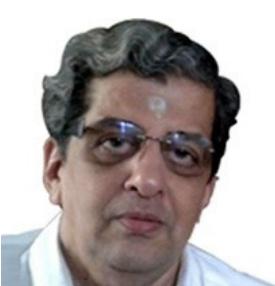
thrive there is a matter to be watched closely. India has provided substantial help to Sri Lanka in their hour of crisis and Ranil Vikramasinghe, the President of Sri Lanka, has acknowledged India’s help. India has repeatedly said that it has done it for the people of Sri Lanka and such an approach alone will help in the long run Just because, we have BRICS, we cannot ignore other nations in our geo strategic approach. Of course, for inter economic cooperation, we can depend on associations like BRICS and ASEAN
We are already doing a lot to our neighbours We are protecting our neighbours Sri Lanka and Maldives and they have mainly the services sector. We are not China and we need not be like them reaching out to every corner of the world, though we have token commitments and representations in Africa and elsewhere For securing the borders, there are only two ways befriending the neighbours in the US way (except in their early years, when they had the Cuban missile crisis) or by putting a heavy foot down on every neighbour, the Soviet way The Soviet strategy did not survive We can only follow the US way
There is not much of scope to expand in trade with our neighbours. The balance of trade will always be in favour of India to a great extent, except with Myanmar and Afghanistan, to some extent We need to have permanent friends with our neighbours. We may have permanent friends elsewhere but in the neighbourhood, friendship is still on a sticky wicket and we need to do more.
There is not much of scope to expand in trade with our neighbours. The balance of trade will always be in favour of India to a great extent...
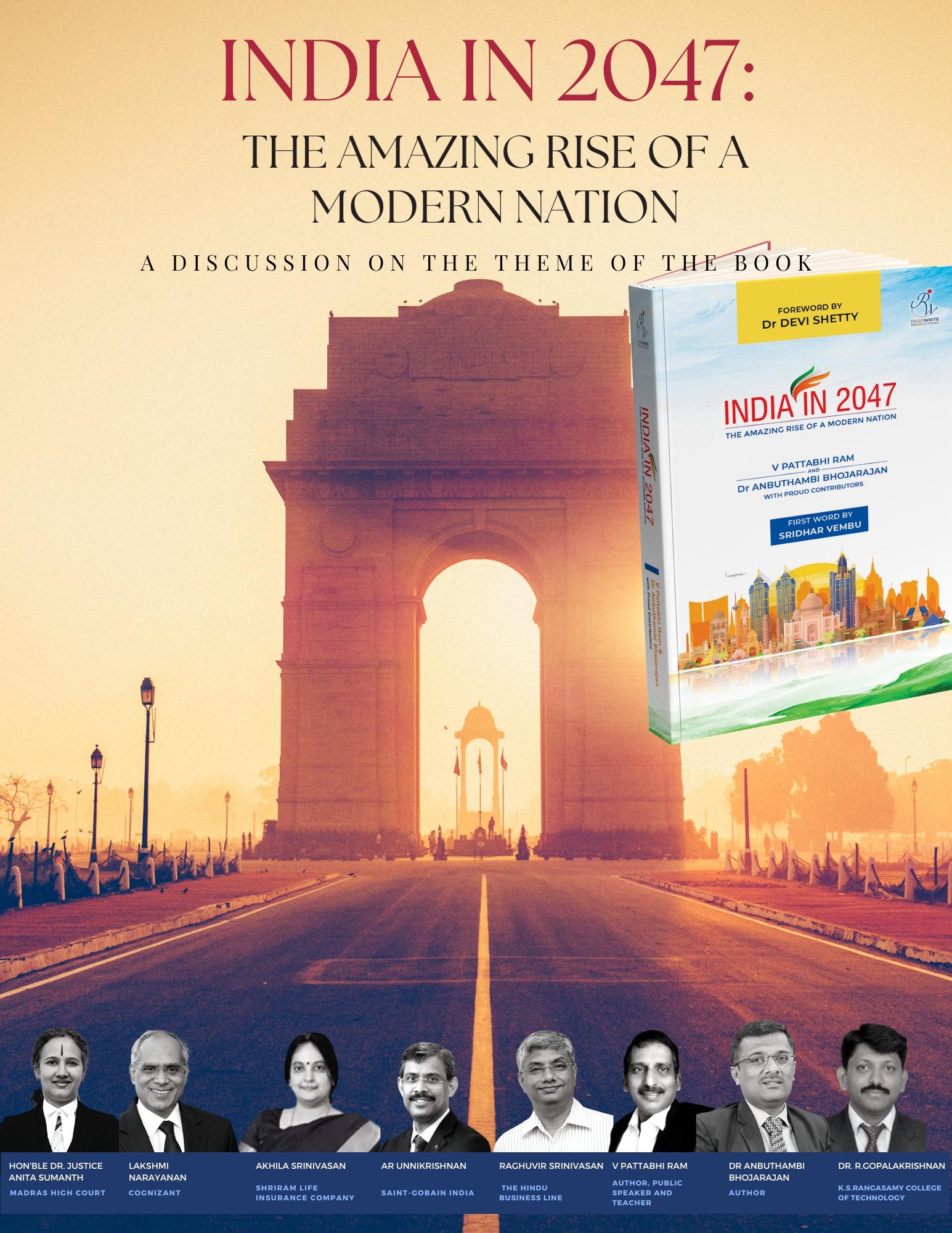
MMA KAS with the support of Read Write Productions organised a discussion on the book "INDIA in 2047: The Amazing Rise of a Modern Nation" authored by CA V Pattabhi Ram and Dr Anbuthambi Bhojarajan, Head Strategy & Partnerships L&T Edutech
What struck me, as I read India in 2047, was that this book is a repository and a ready reckoner of dreams We must identify those dreams that align with our sensibilities, gather our resources and make sure that they don't remain just on paper; we must make them a reality. I would like to share a small anecdote which has its genesis in a couplet in the Upanishads It has been elaborated in great detail in the seventh chapter of the Panchadasi by Vidyaranya.
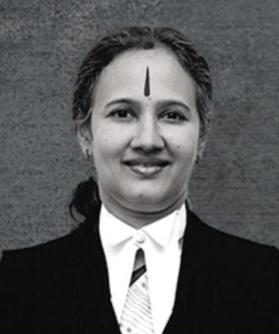
The authors of the book have touched on various areas of the economy that call for development from technology to infrastructure; education to agriculture; and fitness to employment.
The story goes like this Ten men, during their travel, crossed a river and took a head count to ensure that all in the group had reached safely. The first man counts one to nine and then he says, “Oh my God, one of us is missing ” Each one of them counts and comes to the same conclusion. While they were all in a state of panic, a wise man comes along and asks, “What's the problem?” They reply, “Look We were ten to begin with and now one of us is missing.” He takes a quick count and says there are ten people. As they don’t agree, he
suggests that one of them does a head count again The person who counts again says, “See, we told you there are only nine.” The wise man turns his hand to the person counting and says, “Thou art the tenth man.”
This is vedantic, advaitic thought. What is its relevance here? This is a philosophy that is espoused by all Indic religions and faiths and some Abrahamic faiths as well. The authors of the book have touched on various areas of the economy that call for development from technology to infrastructure; education to agriculture; and fitness to employment. There is one overriding feature that is necessary to catalyse and enable all those dreams That feature is ‘us’ or ‘the individual ’ That individual or self must be one of unshakable integrity, full of empathy and fairness and conforming to a set of superior values and principles It is the development of the self that is going to be critical to ensure that the other dreams happen.
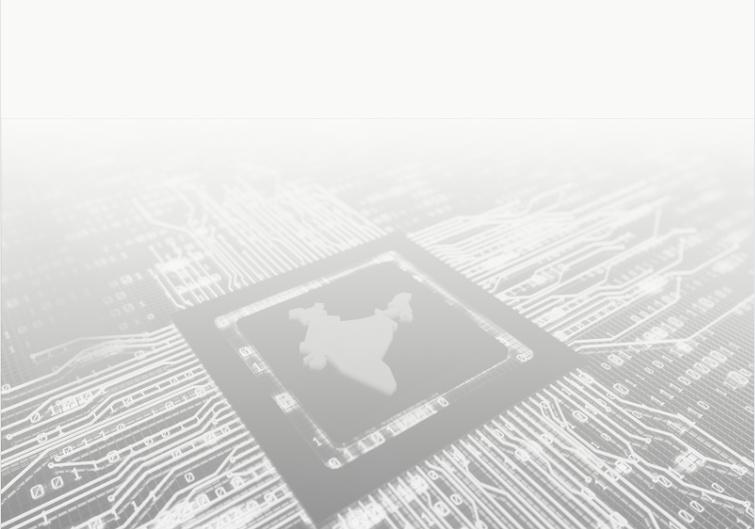
The institution of justice delivery is one of the elements which is critical to the development and maintenance of the society at an optimum level. I was elevated after practicing for about 22 years I look at justice delivery as a service With that elevation, my focus became more broad based and I tend to look at
the ills that plague the system and see what we can do to reduce them Two of those would be the docket explosion and the inexplicable pendency of matters that we have today. The volume of cases that are pending before the courts are mind boggling One of the very effective remedies that one looks at as a countermeasure to that is alternate methods of dispute resolution, particularly mediation There is a Mediation Bill on the anvil, and it is important for ensuring that disputes are resolved in an amicable fashion.
But as a concept, how do we sell mediation to society? We as a society look at litigation as a means to win fully, absolutely, unconditionally and without compromise. That is the anti thesis of what mediation requires. Mediation is an effort which requires the parties in conflict to be able to sit across the table with a neutral negotiator and work out a remedy which would satisfy all of them, not just one of them. Each individual must rise to the occasion. This is the relevance of the vedanta story
Many of our dreams at first seem impossible, then they seem improbable, and when we summon the will, they become inevitable. Let us summon that will. India and Bharat will converge into one unified, invincible, indivisible force.
Mr Raghuvir Srinivasan: I would like to look back from 1947 to 2022 and separate it into three quadrants: 47 72, 72 97 and 97 22. In the first 25 years, we put man on the moon and explored the outer reaches of space. We invented the jet engine which could fly us across the world in hours. The next 25 years (72 97) saw the computer being put into mass commercial use It has transformed people's lives and economies The quarter from 1997 to 2022 has been the most mind blowing period. Who would have thought that the mobile phone would be invented and that it would take over our lives? It has ushered in a communication revolution. Who would have thought that software would become the driving force behind the development of every industry including medicine?
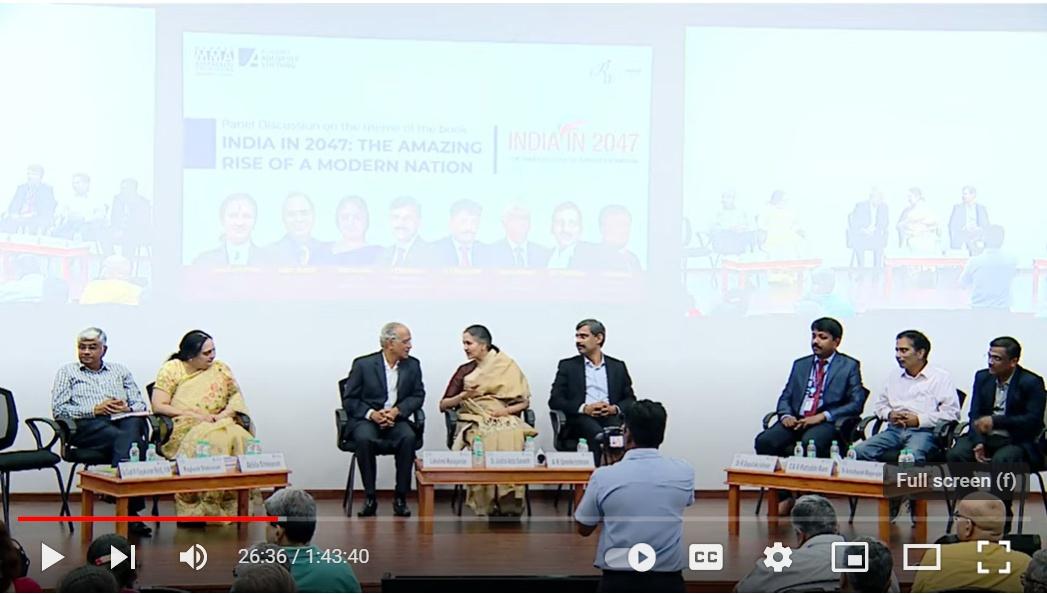

With the advent of battery storage, electric vehicles have threatened fossil fuels, which has till now been the uncrowned king. Could any of us imagine that something called WhatsApp would dominate our lives completely? Technology is driving everything and there's nothing that can be done without a computer
or a microchip In the last few months, the shortage of chips has affected the output of everything from cars to computers and consumer durables to cell phones. How do you see the financial services sector transforming itself to meet the challenges of the next two decades? How do you think that banking and insurance will evolve in the next two decades?
Ms. Akhila Srinivasan: I come from the financial services industry and I have about 35 years of experience both in the financial services entities as well as insurance According to me, we can increase our national income, national output and GDP growth by laying emphasis on non corporate, small businesses of India Banks and asset financing companies are into financing of big assets. The fact is, small businesses in India constitute 6 crore business units. 90% percent employment is created by this sector, which is also called the non corporate sector or the unorganized sector. It contributes to 52% of the GDP of our country, whereas the so called corporate sector contributes only 12% of the GDP This humongous fact has been ignored for decades About 46 crore people are employed in
this sector, out of which 26 crores are self employed This sector includes micro, small units and traders. There is a body called the Confederation of All India Traders’ Union and it has six crore traders as members and 20,000 State Associations all over India About 60% of them are SC, ST and OBCs. But only 4% of their financial needs are met by the banks.
We have Banks, NBFCs, Regional/ Rural and Cooperative Banks The way forward should be the creation of small business financing entities which are a little different from the traditional NBFCs. Banks will have to route their funds to NBFCs, who in turn will route it to Regional Cooperative Banks. The last mile deliverer will be the micro enterprises who can deliver funds to the marginalized trader who needs funds at reasonable rates of interest Otherwise they land in the hands of the money lenders. South Korea and China have created something on these lines. Columnist Mr S Gurumurthy has been talking about a rainbow model of financing, because India is such a diverse country with diverse business enterprises, requiring diverse kinds of credit at very reasonable rates of interest.
The present government brought in Mudra But in my opinion, Mudra is a reclassification of loans that were already given to the priority sector. Nothing new has been created. When the insurance industry opened up, IRDA was created as both a regulatory and
development agency Like IRDA, a small business financing agency should be created, which should focus on the development of finance to small traders of this country. By doing that, this sector will get a huge fillip and unimaginable growth can be achieved
The government must solve the credit needs of small businesses. The rich easily get loans and even manage to get away not repaying them and escaping to other countries It is the small man on the field who doesn't have access to credit My heart goes out to the millions of poor people in this country who are marginalized and whose villages have no access to roads, electricity, basic education and health care But we always talk about urban India where the intelligent and educated elite have a say on the matters. India is a rural economy and an agrarian economy. 50% of the Indian population consists of women and out of that 48% live in rural India. If we keep those 48 percent of the rural India poor and illiterate, then India can never grow
As development happens, there is a constant clash between development and environment. Very often, development takes precedence over environment. As India is rapidly industrialising, how can we ensure that environment doesn't become a casualty? For instance, we need a second big airport for Chennai but the location chosen can displace many poor farmers who have cultivable lands. How do you draw the line between these two?
Mr Unnikrishnan: The first and foremost thing that we need to look at is urbanisation. We are right now around 30%, and it is expected to become 45% by 2030. Urban planning is not one of our strengths and as a country, we need to recognize that. I'm happy that in the recent budget, a small amount has been set aside to work on urban planning It's a good step Institutions, large organizations and architects need to work on that and come out with a good model on urban planning. There are already very good codes and
The present government brought in Mudra. But in my opinion, Mudra is a reclassification of loans that were already given to the priority sector.
~ Ms. Akhila Srinivasan
standards on green / sustainable buildings We see a lot of electrification of mobility with EVs coming in.
By 2070, India has committed to be carbon neutral. This has to be aligned to many sectors. The management practices must percolate down to the last person in the organizations. In Saint Gobain, we have an objective that by 2050, we will be carbon neutral. It doesn't matter if we are in France, Germany, India, China or US What we do in the next four to five years in our business, in our investments and technology will determine whether we will achieve that objective in 2050 Cities and States must put in the right policy framework and enable that India as a country is still poor and we need development. There is no doubt on that. We have less than $2000 per capita income.
Can we have economic development without disturbing the environment? It is very much possible thanks to many countries that have done all the mistakes in the past. We can learn from them. China is now tightening on the environment norms Not 30 years back Their norms today are much tighter than what it is in Europe or US.
ESG is now widely spoken about as a big deal in organizations It is nice to preach but we should also practise In our Sriperumbudur factory, nine months of our operations are run from rainwater collected from
the roof We don't take any water from the ground We have over a lakh trees planted over there We have enough roof and we have put solar modules to have renewable power. There are things that we can do at home and we should do that Some of these will be a little costly to start with
We need a lot of skilled people as we go forward to achieve our dreams be it in technology, manufacturing or services. You come from an engineering background. What do you think we lack in terms of skilling? What do we need to do to take India forward in producing the right kind of engineers, architects and planners?
Dr Gopalakrishnan: Education is a knowledge based industry. We are not focusing on skills because it's a kind of a pyramid. We have school education. When we go for higher education, there is a huge drop After the higher education, people go for post graduation and doctorate. At every level, there is a drop. There are two kinds of jobs blue collar and white collar. There is a big competition for white collar jobs than blue collar jobs. If you take engineering and compare it with the diploma, the diploma holders will get a placement easily because their focus is more on skilling and laboratory work We must focus on activity based learning; that is, learning by doing. The new National Education Policy 2020 talks a lot on this learning by doing and there is a chance for giving more importance
China is now tightening on the environment norms. Not 30 years back. Their norms today are much tighter than what it is in Europe or US.
~ Mr Unnikrishnan
The new National Education Policy 2020 talks a lot on this learning by doing and there is a chance for giving more importance for T type of learning.
~ Dr Gopalakrishnan
for T type of learning We call it as horizontal exposure and vertical expertise. That is missing now.
There are 43 subjects in engineering. If I get some 170 credits, I will be an engineer Unfortunately, the deep dive in any one subject is missing It is not about blaming. The faculty’s role, particularly during the Covid, changed a lot. We have realized that. Their role in future will be totally different
So, in education, transformation is highly needed Now it is all about imagineering. In technology, we first talked about IOT. Later, it became the Internet of Everything Now, it is AIOT (artificial intelligence of things) For all these developments, content for teaching is available. To handle that content, faculty members should be enabled and for that, we need a lot of support from the industry In the US and other developed countries, the education industry is governed by industries. Example: Stanford and the Silicon Valley. Training and placement is the buzzword everywhere We talk about dream packages and super dream offers But a skilling officer is missing. Students are not able to meet the expectations of the core industries, though IT industries can make up for this gap
Apart from training and placement, we must also emphasise on students becoming entrepreneurs. To become an entrepreneur, money is not the only factor.
More than that, students should be highly skilled For that, a lot of incubators are needed So more than making them employable, we must also make them employers, for which, again, skill based education is highly demanded Forget about 2047 Even after five years, we don’t know what changes will happen in the industry. We are discussing SpaceX and Hyperloop. We must incorporate all these in our syllabus My submission to the government is that more number of autonomous institutions should come. That will make some difference.
The greatest disruptor is technology and that's also the foundation of everything as we go forward. Are we investing enough in research and development in India? We find that most of the scientists fly abroad and they do better than what they would do in India. What should we do to ensure that we become a hub of R&D and advancement in technology?
Mr. Lakshmi Narayanan: There are many people in the past who thought about things that are making a difference now Satyendranath Nath Bose, a famous scientist, talked about Boson, the fundamental particle that makes matter. He just theorised it. It was proven only a few years ago through experimentation. Likewise, Einstein dreamt of gravitational waves That is being proven Alan Turing in the 1950s talked about artificial intelligence. They evolved the test called Turing Test, which says, artificial intelligence would have arrived when you cannot make a difference between a person and a computer in logical, rational thinking and not emotional thinking. This was formulated in 1950 when computers were not popular at all It is expected that by 2030, the Turing Test will be proved
Homi Bhabha in our country talked about three stage nuclear program. The third stage of thorium based nuclear power is now underway The fuel has been formulated and it's undergoing tests So there are many people who made predictions
with good
Many of the new creations like the blockchain and cryptocurrency are all things that were created by people under 35. They have nothing to lose. They are fearless. They don't carry any baggage.
~ Mr. Lakshmi Narayanan
knowledge They not really dreamt but had some fundamental knowledge and did a lot of research
Coming to genetics, people said it would take many decades to do the entire human genome sequencing. Now it's done. In 2002, it was predicted that brain mapping would be very difficult Brain mapping will tell which part of the brain contributes to which kind of emotion, memory and intelligence. In the next four or five years, we will have an entire map of the brain, so much so that it is possible to replicate a human brain or simulate the human brain on a computer. We have heard of digital twins for machines. Very soon, we will have digital twins for individuals like us Our personal identity will be in the digital form, which you can keep under lock, and key, as there's so much of information that we use and leave in the net. The digital twin can track human habits For example, if you're regularly buying a particular type of toothpaste every 20 days, in future, your digital twin will take care of that The challenge is that someone may create a deep fake
Many of the new creations like the blockchain and cryptocurrency are all things that were created by people under 35 They have nothing to lose They are fearless They don't carry any baggage If we look into the future, we must take care of a few things. They always say that the purpose of an education system is to shift the burden of education to the individual They have to take ownership and responsibility and learn Digital learning is helping self learning in the areas of critical thinking.
There are so many changes that are happening thanks to computing devices and the computing power that is at the hands of the people and the communication devices that are there. Nobody would have imagined about the Google Maps and the Google
Earth. There are already about 6,000 satellites in space. This number is expected to increase to 1 million in the next 20 years Companies are worrying about how to avoid collision of satellites and traffic jams. The US is preparing to put 5 million drones in space by 2027 2028 There is a system evolved by NASA that will give priority to the drones. It will have an ambulance zone and clear the way for medical emergency drones.
In such a scenario, we in India are in a very good place, going by just two or three data points We are no longer a poor country, based on a study published by UNDP. They looked at 10 different parameters like nutrition, school going years, child mortality, sanitation, cooking fuel which adds to climate change, etc They have said that from 2005 to 2015, 415 million people have come out of poverty in India.
The future is going to be better and faster. Computing power is going up so dramatically The AI algorithms that people develop are doubling every three or four months. In another five years, the rest of our population can come out of poverty
Regarding R&D investments, it is the highest in high growth industries. If we can find a way of storing energy for long periods of time, we would have cracked the climate change problem and it is possible There are people who are using ice batteries that store usable
The future is going to be better and faster. Computing power is going up so dramatically. The AI algorithms that people develop are doubling every three or four months.
~ Mr Lakshmi Narayanan
6
~
~ Mr Unnikrishnan
energy Apart from renewable energy, a lot of research is going on in the areas of space, aviation, computing and healthcare.
You talked about the unbanked—the financially excluded. Don't we have microfinance companies that are doing this job pretty well?
Ms. Akhila Srinivasan: Given the size of the country and the underserved population in terms of credit, the number of microfinance entities are very, very less. There are both well run and poorly run microfinance institutions Considering the population, the penetration that has to be achieved is really big When formal credit is denied, people go to money lenders who charge very high interest rates. Reading history, we can see that during the period of Raja Raja Cholan who ruled in the south India, they had a system whereby the poorest of the poor would get access to credit at very less interest rates, because they wanted to preserve the dignity of the people Water management was also at its peak at that time. We all talk about technology, advancement in education and so on But I would also think that by 2047, are we going to be a happy people?
Talking about energy, a lot of money is being put into solar. Wind power has been there for many years. Do you really see these renewable sources replacing fossil fuel anytime in the future? What do you have to say about the hypocrisy
that we are witnessing in the west? When they are in a crisis, they throw away their climate goals and go back to reopening of closed nuclear and coal fired plants, because gas is not available.
Mr. Unnikrishnan: Countries are a replica of human beings We behave in one way when we are in a comfortable situation and very differently when we are under stress. Regarding renewables, I think the stars are aligned for India We have a lot of sun Our overall installed capacity in India is less than 50 GW This is nothing compared to our objective of 300 GW by 2030. This industry has caught the imagination of different stakeholders starting from the government to investors to everybody Thanks to certain right investments and policies, the market has discovered a good price level. Today, a viable solar renewable power can be obtained under 4 rupees per unit
By 2026, 100 percentage of the electricity that we use in our manufacturing facility which runs into many megawatts will be renewable. We are already in that path and we have now reached 40% So for a country too, it’s very much possible and also a necessity. Thanks to renewables, the energy is closer to the users and this overcomes distribution problems Also, on hydrogen, it is good that India has identified it as a key source of energy.
The myth that automation will increase unemployment is long forgotten. Even the trade unions don't buy that argument anymore.
Mr. Lakshmi Narayanan
We have three issues: affordability, security and economic impact. We spend Rs.
lakh crores on importing energy.
We have three issues: affordability, security and economic impact We spend Rs 6 lakh crores on importing energy. Big businesses are investing large amounts of money on R&D in usage of hydrogen as a fuel One challenge here is transportation because of the explosive nature of hydrogen It is an opportunity as well. We are working on converting some of our manufacturing plants to use hydrogen. It is not easy though and it requires decades of work
When we look at universities in the US, the linkages with industry are very strong and mutually beneficial, whereas in India we don't see that happening. Is that a reason why we are churning out graduates who are unemployable and who need further training? How do we change this?
Earlier we were talking about employability. Now, it is about deployability. Our faculty should go to the industry We call it as sabbaticals It may be for a week, a month or six months We have a scheme called ‘one faculty, one industry.’ The faculty should have contact with the industry. We have more than 25,000 alumina working in different industries who can be approached We also make internship as mandatory for six to eight weeks. In a year or a semester, students should have at least 40 hours of industrial relevance. Third, to make the students industry ready, we must bring the industry culture to the institution. We can set up a Center of Excellence. People with industry experience can join our faculty as adjunct faculties They can be on the
board of educational institutions And finally, earlier we were talking about interdisciplinary and multidisciplinary approaches. Now it is going to be trans disciplinary. You should have the flavour of industry in the institution for that The faculty should be highly connected with the industry and collaboration should happen.
Mr Lakshmi Narayanan: It may destroy jobs but it will create new jobs too. In the last 25 years, formal employment in the country has not reduced at all. If anything, it has increased and unemployment has come down, both due to the growth in the new opportunities as well as informal sectors moving to formal sector, etc So the myth that automation will increase unemployment is long forgotten Even the trade unions don't buy that argument anymore. The demand for skills is the challenge. Because of open innovation, if I innovate something today anywhere in the world, it becomes available to the rest of the world at that same moment for them to exploit. That's the level of collaboration that's happening. It is one of the reasons why millions of people are coming out of poverty Globalization means free flow of capital, ideas and people. As long as we have globalisation, free trade and entrepreneurship, we don't need to worry about em ployment

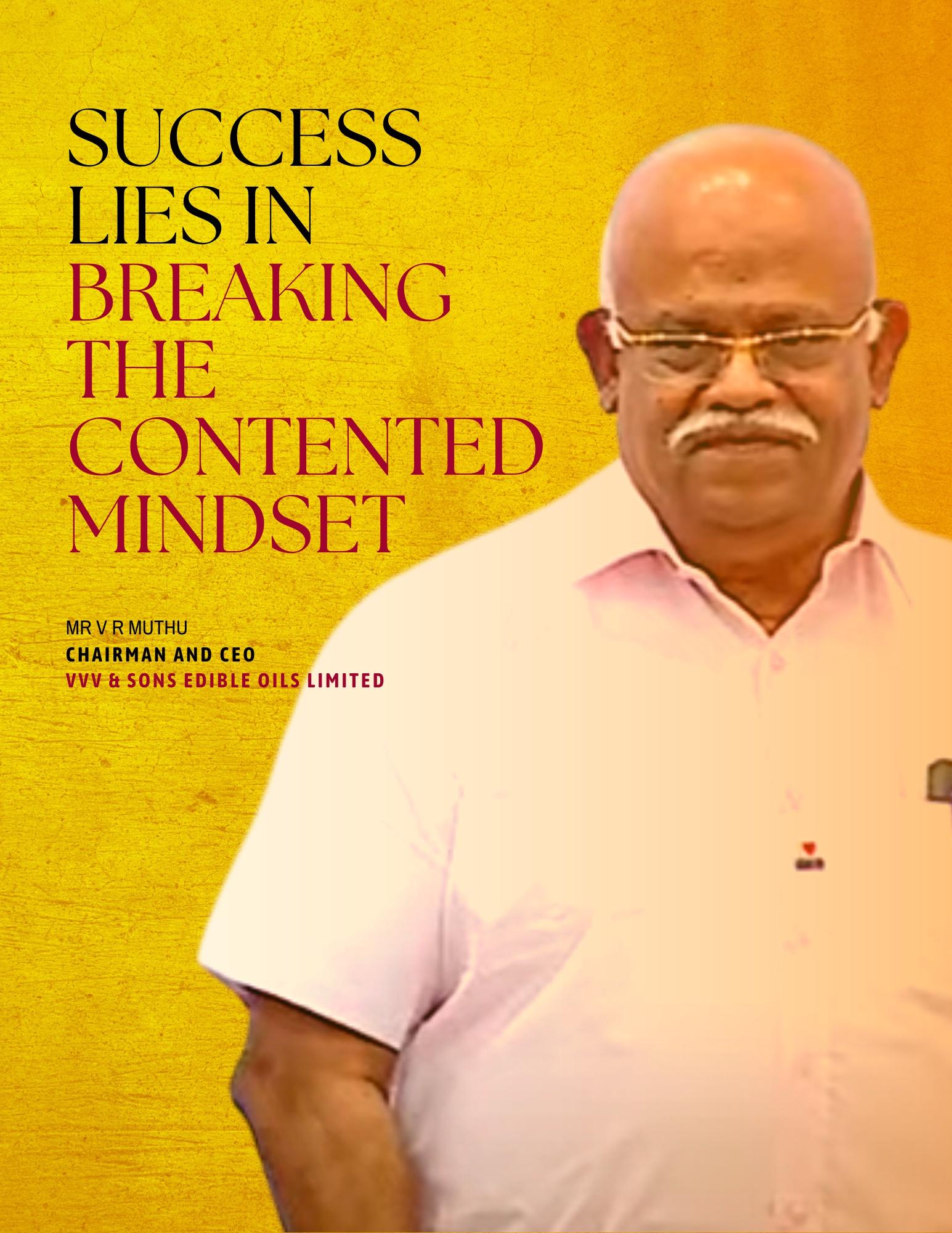
Under the "Success Stories How it was done!” series, MMA organised a discussion with Mr V R Muthu, Chairman and CEO Mr C K Kumaravel, CEO & Co Founder, Naturals led the conversation The discussion focussed on the early influences that shaped the business philosophy of Mr. Muthu.
As a child, I had been to Courtallam falls with my family and relatives After taking bath in the falls, we came out Seeing the water continuing to flow from the falls, I asked my father, "Can you ask someone to stop the motor? Water is getting wasted " I didn't know then that there was something called as a natural waterfalls. I was concerned that water should not be wasted and that was thanks to my parents' upbringing My father always would insist on switching off lights and fans when no one was in the room. My father had arranged tuition classes for me at Rs 100 per month. Once, the tuition master announced a day's leave, as he had to travel to some place I went and told my dad, "Today my master has declared holiday. So can we reduce the tuition fee?" These are just instances that showed that I had a natural business sense even as I was a young lad I also recall taking a flight from Chennai to Madurai, paying just Rs 90 as the flight fare.
caught. Can you recall about your school / college and teachers who made a difference to your life?
I studied in Virudhunagar at the Kshatriya Vidhyasala (KV Sala) school It was known for discipline Mr George, the Principal, was very strict and everyone would dread his name. Thanks to that discipline, I passed SSLC with 75%, which was a very good grade then. Then I joined PUC at St. Joseph's College, Trichy, which was then equally known for discipline and would be called more of a school than a college There used to be 'silence hours' in the hostel I passed PUC, again with 75% grade. Then, I moved to Bombay University and joined a college for my intermediate education.
Mr Kumaravel: In my family, we grew up as six children. When we finished eating, our plates would be clean. We were brought up with the message that nothing, including food should be wasted. They say that values are not taught, but
At that time, the Tamil Nadu was witnessing continuous agitations against the introduction of Hindi in curriculum and the colleges were closed for almost 6 months in a year. That's why my dad moved me to Mumbai to stay clear of the agitations He also wanted me to pick up English and Hindi The college I joined was not strict. It was very liberal and one could walk in and out of the classes at will. The hostel windows did not have a grill So we could enter and exit through the windows.
Every Friday, a Hindi movie would be released and we would go to the movie As a result of this transition from a disciplined to a very liberal setting, my studies suffered and I did not prepare well for the exams. I prayed to Lord Ganesha, yet I failed in the exams. This, in spite of my scoring well in my school and pre university The lesson is that Lord Ganesha helps only those who prepare well. Where there is discipline, there will be preparation. Where there is discipline and preparation, there will be success If both are absent, there will be failure. I am a standing example for this. The problem and the solution are both within us. Can you tell us how your mom influenced you?
My mom would recite many Tamil proverbs Some of her favourites are: A patient person can rule the world; A mouth that tells lies will not get food; Stay far away from evil; Don't step into the house of one who does not respect you All these have influenced me I also tweak many of them and come up with new
proverbs to reflect the business context. For instance, one proverb goes, 'A contented mind is a medicinal elixir ' This will be apt when we eat or do shopping Unfortunately, many business people in Tamil Nadu latch on to this proverb. According to me, for entrepreneurs, this is not applicable, as they should focus only on growth, growth and more growth I have seen such a growth mindset in the people of Mumbai and Coimbatore. The reason why companies like Idhayam succeed is due to lack of this growth mindset on the part of our competitors We are No 1 in sesame oil sales in the country. We are in this trade for 80 years. We are No.1 in groundnut oil sales in Tamil Nadu, even though we started its production only 15 years ago. Credit for our achievement goes to our competitors who have a contented mindset.
They confine their market to the towns in which they manufacture They do not want to grow beyond that. When we want to market throughout Tamil Nadu or across India, we are able to succeed easily.
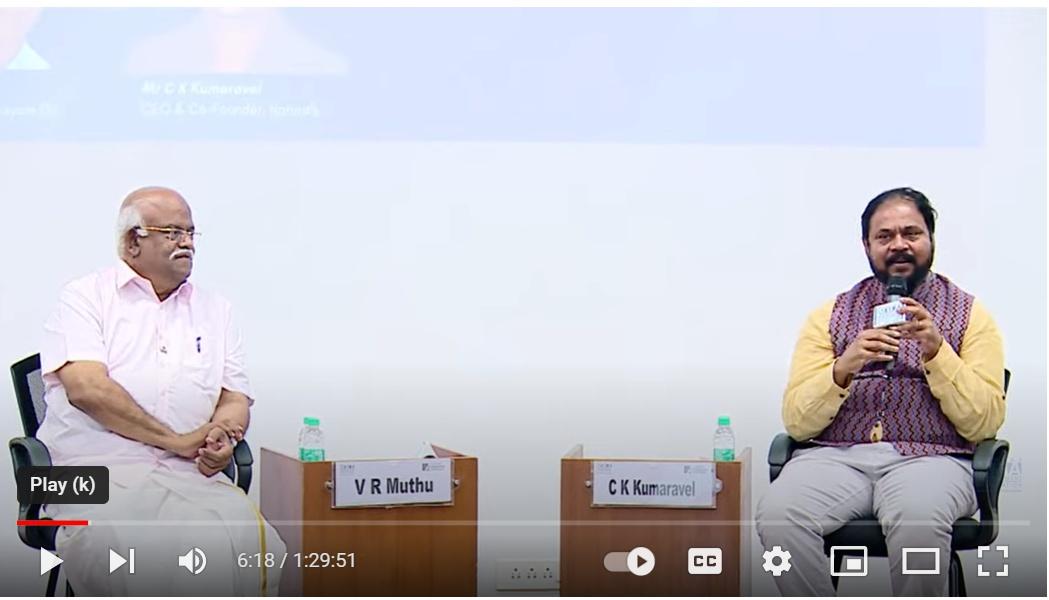
One of our distributors in Mumbai had gone to the night show to watch a movie. He got a phone call. The caller wanted 2 litres of Idhayam gingely oil immediately Irked by the call, the distributor disconnected it Again he got the call The caller repeated his request and pleaded not to disconnect. He said, "If you can deliver now, it will go by tonight's flight to New Delhi and from there, by an early morning flight to Moscow, where in two days' me, it will be used for our Prime Minister Mr Narendra Modi's breakfast, for mixing it with chilli powder and serving with idlis " The request was made by a caterer from Mumbai
Our distributor was taken aback by the request and its importance. He rushed out and immediately delivered the gingely oil to the caterer, which reached in me to Moscow for the PM's breakfast This anecdote was shared by our distributor The message I want to tell you is that if you deliver a quality product, even the Prime Minister can become your customer.
Another proverb goes as, "Would one offer wages for eating sugarcane?" When you eat sugarcane, it is so sweet. The very act of eating it by itself is a joyous act. So why would anyone demand a wage for such an act? It means that when someone does something that he/ she cherishes, they don't expect any other compensation. I have tweaked this one too as, "Eat your sugarcane and demand wages " What I refer to is that one should take up a role or task that one is passionate about and still, make money doing that. For instance, AR Rahman loves music. For him, composing a song is his piece of sugarcane Yet, he gets richly paid for his works For PV Sindhu, playing badminton is her eating the sugarcane. Yet, she makes millions of dollars out of playing the game.
Whatever you do, you must do it to your best For instance, I am a marketing person I have been in marketing for 40 years. My brother Sathyam is in production for the last 30 years. We don't swap our roles Marketing is my passion and production is my brother's forte Do what you are passionate about They say that rain fills the size of the vessel you carry. The larger it is, the more water you can collect. This refers to the
growth mindset. Tell us how your family started this sesame oil business and the early days.
My family was doing trade on a commission basis even before the 1940s. They had establishments in Colombo, Rangoon, Karachi and Mumbai of the British era When they were in Rangoon (now Yangon), the World War II started and Japanese bombarded it So the Indian business people were asked by the British to move to India. Our family members and agents moved back to India The British government announced that the income from Rangoon operations need not be shown for income tax purposes for the reason that the books of accounts might not be available with people who were fleeing the war zone But our elders had copies of the accounts of Rangoon operations in Virudhunagar and they voluntarily declared to the government that they would pay income tax taking into account their Rangoon business also
Such was the tradition set by them being honest and values driven. When my grandfather died, my father put up his photograph in our house with the three letter mantra that grandpa had instilled in our family: Truth, Hard work and Growth. 'Where there is truth and hard work, there will be growth.' This
There is a proverb which says, "Search and you will get it " I have tweaked it as, "Search and you will get even what you didn't search for." Columbus set on a voyage to discover India but he ended up discovering America. We focussed on marke ng our products only in the region between Chennai and Kanyakumari But our market has grown not just in India but beyond, right from Toronto in the North West to Sydney in the South East This has happened as our sa sfied customers in Tamil Nadu have spread their wings, all across the globe. The market that we searched for was Tamil Nadu but the one we got is the global marketplace
philosophy guides us in all our businesses till today
In the early days, we were trading agents, sourcing multiple types of grains from our principals based in North India We sold exactly at the prices fixed by our principals What was our revenue model then? When we received the goods, we would pay 80% of the value to the principals, for which they would pay us interest. For storage of the goods in our warehouse, we got rent On sale of the goods, we got commission. So, it was a combination of interest, rent and commission. This was going on for several years
At one period, sale of sesame seeds was going on very well. In Virudhunagar, there was a sesame oil producer, for whom we sold sesame seeds in large quantity Suddenly, he ran into financial difficulties and was planning to wind up his business My grandfather and his three brothers stepped in and discussed how they could overcome the loss of their business from their key customer the oil producer "Why don't we get in to the business of producing sesame oil?" They deliberated this model of forward integration that is, producing sesame oil and thus we started producing sesame oil This was in 1940 Since then, we are into this business.
All four brothers were together managing it till
1943 VV Dhanushkoti (popularly known as VVD) is one of them. The VVD Coconut Oil is the first brand launched from our family that became popular. Till 1986, we sold sesame oil under 'Anandham Brand ' Then there was a family partition and 'Anandham' brand went to my uncle. My father asked us to think of a new brand name "Sakthi" was the brand name we first came up with, printed our labels and even created jingles, using popular female playback singer Vani Jayaram, but we learnt that someone else was selling sesame oil under that name in Erode So we scrapped that idea and all the labels and thought of another brand name.
At that time, we had a tag line for 'Anandham' brand It was: Friendly to the Heart (Idhayam in Tamil) We decided to use the word 'Idhayam' as our new brand name. On December 1, 1986, Brand Idhayam was born. At that time, there was only Roopavahini (Sri Lankan TV Channel) broadcast in Tamil Nadu On 14 January 1987, DD Tamil TV Channel was offered to people of Tamil Nadu after the installation of a TV Tower in Kodaikanal On the day of Tamil TV launch, we launched our TV ad, featuring actress Chithra In the commercial, she would tell her husband, "I didn't ask you to cook or wash clothes. I only asked you to buy Idhayam Gingely Oil,” to which the husband would ask,
“What is so special about Idhayam?” She would highlight the taste of the oil and say, “This is a ladies’ subject. Why don’t you just go, get it?”
This commercial became a super hit for many reasons It had its share of controversies too Men objected to it saying that the wife in the ad demanded her husband to just go, get it, without asking questions. Women objected to it asking if cooking and washing clothes were purely in their domain The net result was that the sales of Idhayam oil increased. A person from Madhuranthagam claimed that he would walk all the way from his place to Doordharshan (DD) building in Chennai and break the television set if DD did not stop airing the ad. DD ignored that threat and continued to broadcast the ad.
One major reason for the huge success of the commercial was that it was conceived in Tamil and written in Tamil. Most of the ads would be produced in Hindi in Bombay and then dubbed in Tamil. Also, director and actor Bhagyaraj was popular at that time Our ad's dialogues had a flavour of his style Added to that, TV remote was not in vogue at that time, so people could not switch channels during an ad! After remote came, we have gradually moved away from TV commercials. When you were about to lose a major customer of your sesame seeds, it was a major challenge. But you converted it as an opportunity by starting sesame oil production. This tells us that entrepreneurship is all about converting challenges and threats into opportunities. One can look at a glass that it is filled to its half either as half-empty or halffilled. Can you tell us about Leka Ratnakumar who created that ad for you?
Leka Advertisers and Film Makers have been designing and printing our labels since beginning All our ads are being done by him, right from the first one. Leka Ratnakumar is a very creative artist. All his works
n
o
have been commercial hits He did a commercial for us featuring actress Jyotika Within a year or two of this ad release, the hugely successful Tamil movie, 'Dhool' was released which featured actors Vikram, Jyotika and comedy actor Vivek In three places, Vivek had made a comedy, linking Jyotika and Idhayam gingely oil Even if Vivek had asked us ten lakhs to use our brand name in the movie, we would have paid him. But he did not demand anything from us and thus it became a free publicity for us. It is true that free publicity is the best publicity. All the credit for that commercial must go to Leka Ratnakumar and his team
The song in that commercial was rendered by Srilekha Parthasarathy After the release of the ad, she got many offers and became very popular. Chandramohan of Hatsun Foods and I are close friends for 50 years Hatsun did an ad with actor Simran So we roped in Jyotika. She is such an amazing and wonderful actor that the director will say, 'Start' to commence shooting her but would be very reluctant to say, 'cut' when she is performing I have heard of actors asking, "Are we done with the shoot?" But Jyotika will continue to perform, totally immersed in the role that she does We use her photo in our labels In fact, in the US, we tell our customers to see if our sesame oil carries Jyotika's image and if not, it is not a fake. There is one more Idhayam brand sold in the US without Jyotika's image We are fighting a long legal battle in the US against our brand name being misused by another company. Team Leka is totally committed to Brand Idhayam
Tell us about meeting our late Chief Minister Kamaraj who revolutionised school education in Tamil Nadu by starting numerous schools and introducing the noon meal scheme that brought many children to the schools. Thyrocare Velumani would recall his school days saying, "I went to school with a slate in one hand and a plate in another hand."
In oil produc on, press, rotary, expeller and refining are the evolu on of technology We are using expeller If we use refining, we may not get the taste and flavour of gingely oil, which is mainly preferred for its special taste We follow the best process for cleaning the raw materials using latest technology and deploying machinery imported from Germany, apart from sourcing high quality raw materials
We may not have the best smell and that is because of the high tech cleaning process that we follow. When cleaning is not done perfectly, you get a good smell I invite you to visit our factory in Virudhunagar and see our produc on process I promise you that we will serve you lunch which will include idlis served with chilli powder and our own Idhayam brand gingely oil.
Next to our school was the Travellers' Bungalow. I was doing seventh standard and Kamaraj had stayed there in 1965 As school students, we went and met him His gigantic figure is still fresh in my mind He asked us what we were doing. When we told him that we were studying in the nearby school, he asked us to get back to the school immediately Kamaraj was known for being austere. I can proudly tell you that our town Virudhunagar played a big role in instilling this austerity in him
Before he introduced free education in Tamil Nadu, Virudhunagar town already had free education in place. He saw and was inspired by that model, which he then scaled up in Tamil Nadu Even before India got independence, Virudhunagar had a college and built good buildings for the educational institutions. Every household had a tradition of saving a handful of rice everyday, which would then be collected by an association This rice was shared with the teachers, thus making free education possible, even in those days.
Also, the Virudhunagar traders followed a system called 'makamai,' of contributing voluntarily a tax, proportional to their sales This would be pooled by the community and used to run the educational institutions. In fact, earlier, Rajaji (Rajagopalachari),
then Premier of the Madras Presidency visited Virudhunagar and was impressed by the educational institutions and their infrastructure When he asked the people how they ran them, our town people explained to him about the voluntary Makamai system. This thought sank in him. When he went back, he introduced the sales tax for the first time in India So fortunately or unfortunately, the traders of Virudhunagar have played a part in the introduction of sales tax.
Can you take us through the women empowerment in your family…
My wife runs a boutique 'Thozhi' They stitch designer blouses and have customers from as far as Seattle My daughter in law supported by my wife manage a concept called 'garbage bank' in Virudhunagar, collecting non biodegradable household waste from 700 houses, some schools and the General Hospital It is segregated into 45 categories Recyclers are identified and the waste is sold to them We pay the residents for giving us the waste. It is managed very well. From 700 houses, they have plans to scale it up to 7000 houses For the last 5 years, no waste from our house has gone to the municipality
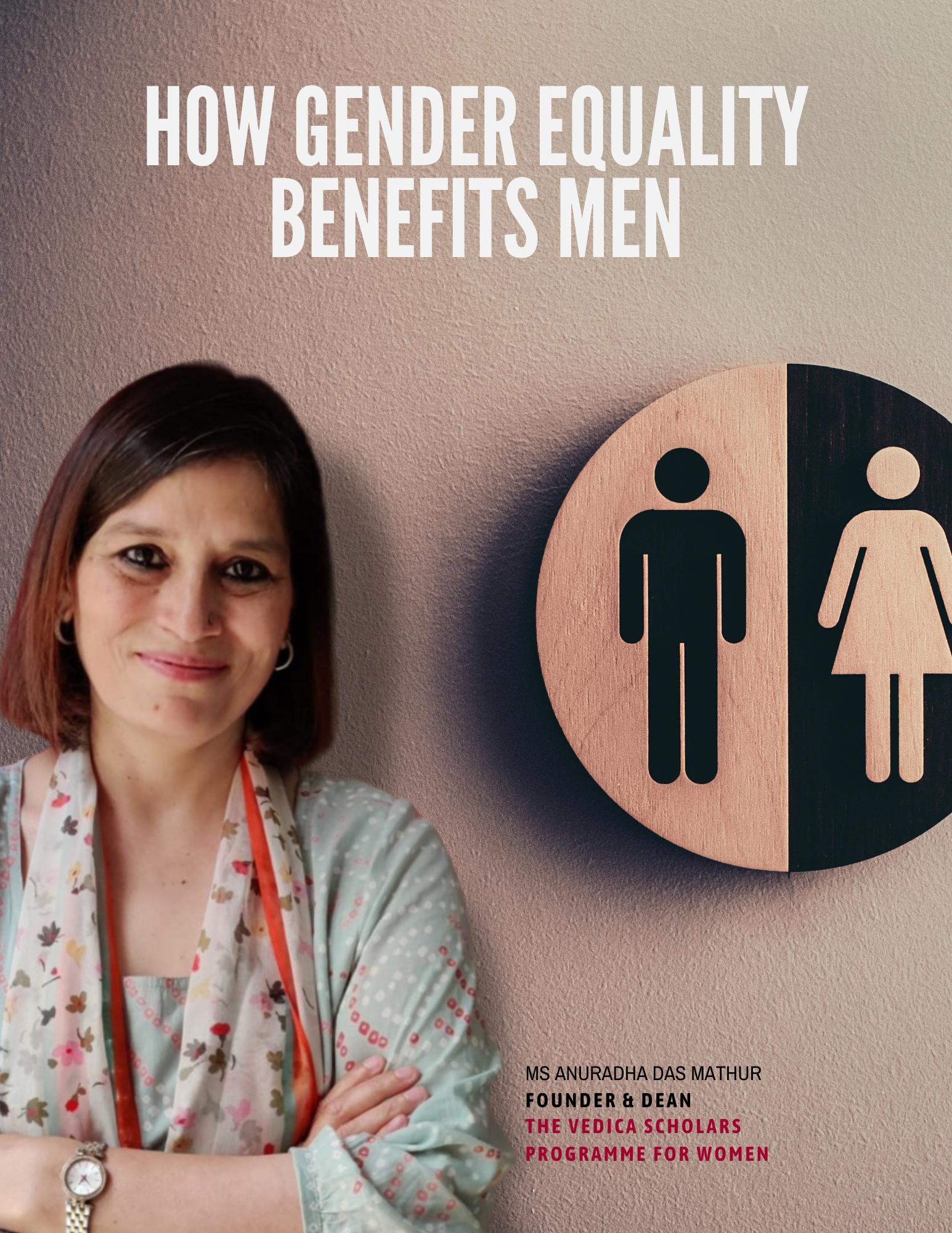
Ms Anuradha Das Mathur, Founder & Dean, The Vedica Scholars Programme for Women & Director, 9 9 Group India, shares her thoughts on what liberation means for both women and men Ms Mythili Chandrasekar, Consumer Behaviour and Brand Strategy Enthusiast, led the conversation
Ms. Mythili: Why do you say that men are at a disadvantage when it comes to gender equality?
Ms. Anuradha: The issues that we're talking about are so big and deep rooted, that there's no question of any one person’s or even 20 peoples’ work making a change When we think about gender equality, it's not women's equality but gender equality. We keep thinking that women are at a disadvantage The truth is that it is not ‘us versus them’ at all. We live in a world where men and women are both disadvantaged by this deep rooted notion of patriarchy So what it does to women, it also does to men. Everybody wants to be successful. The common notions of success are totally associated with men's lives and what they do, because money, achievement and power are so central to men, in our thinking. Women have been relegated to the confines of the walls. There is an interesting study done around happiness for men. And the truth is
relationships and hobbies are taken away from men, because they have to fend for themselves, their families and communities and everybody around them There is this burden of the stereotype that women feel ‘we are pushed into the house and we can't go out’; and the men are ‘pushed out and they can't find their way into the house ’ This burden of expectations, stereotypes and societal pressures are deep rooted for both sides. In fact, patriarchy is damaging to men
We believe that it is women against men, because we are looking at a zero sum game We live in a world where everybody can be better off, if it was more equal. When a family goes out for vacation, the man carries the burden of making that experience possible for his entire family How tough it is! The pressures that we put on men to make them feel like they are
worthy and successful, are absolutely untenable. Increasingly, there are men who want to be a primary parent. They like to be there for their parents, when they are ill They'd like to be able to help a friend in trouble But if your boss calls you and you have a job commitment, then you don't have those choices at all.
The last thing I want to talk about is that our focus always is on making women financially independent. Our organisation Vedica was set up to do that. But we don't ever think about the fact that if we focus on women becoming financially more independent, we will liberate men to be able to follow their heart a little bit Why should the world allow only women the opportunity to follow their heart and men to only follow their heads?
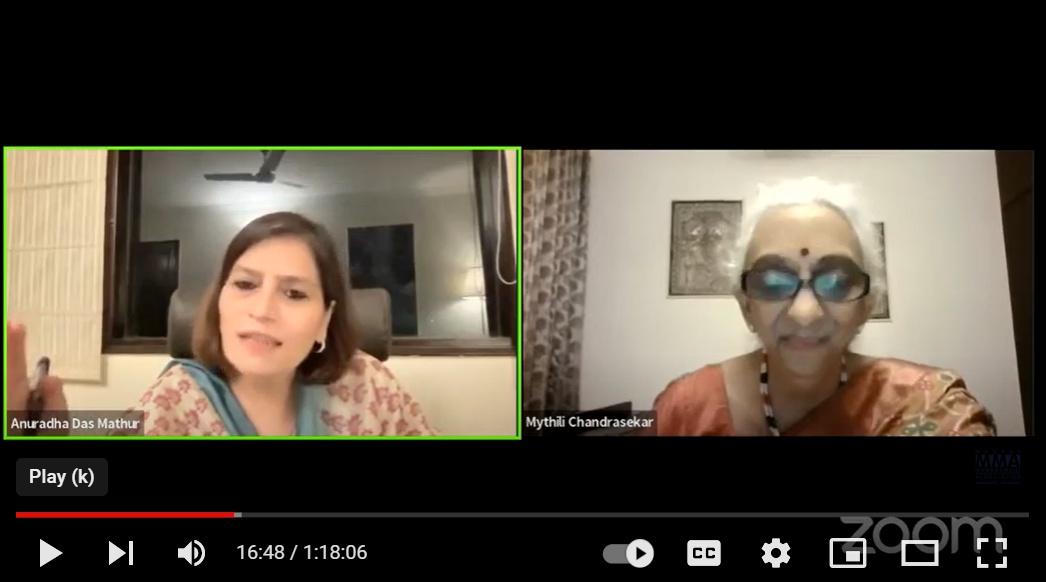
The number of men who commit suicide because of failure, every single day in India, is more than double the number of women who
The number of men who commit suicide because of failure, every single day in India, is more than double the number of women who commit suicide.
commit suicide The second thing is, where there's a dispute, they just assume that the natural parent and the only person who can really care for children is a woman. Lots of prejudices exist
The third thing is physical strength Nutrition is the same for men and women. But imagine if you have a son who can't lift a suitcase and put it into the loft The shame and the inadequacies that are associated with not being physically strong can be devastating for men. We have to bring the same level of
empathy and this lens when we talk about equality. We have to make the world as equal for men as it is for women
Do you think that women are aware of this and do they see men through this lens at all?
Success in a conventional sense is all consuming and overrated. We don't look at rich persons with any kind of sympathy Because money and power are meant to make up for many other things. I don't think that's true. That's why people regret about what they didn't do, when they reach 70 and 75 We are not giving women the opportunity to feel fulfilled outside the home and for men to feel fulfilled in their personal life.
We tend to see men as the establishment and, in general, we lack empathy with any establishment. What happens when women enter the workspace?
The participation of women in the workforce is less than 20% in a nation where higher education has grown by leaps and bounds. Lack of financial independence is a source of indignity Dignity and dependence don't go hand in hand That's something I've discovered. We are so keen for women to be financially independent, so that they can hold the reins of dignity in their hands
Global research shows that women do more
than three times the amount of work than men do, in the home space doing domestic chores
In India, women do 9.8 times more domestic work than men. So where is the time to go to work?
The third thing is, girls are brought up to believe that they have a choice. Men are brought up with not having that choice. Now, unless this becomes the same, how will you have equality in the workplace? I have so many friends who say, “Oh, I'm not enjoying my job or I don't like my boss, I quit.” How many men are able to do that? They live lifetimes of working in jobs and sectors they don't like They suffer all kinds of nonsense at the hands of a boss who doesn't like them. They can’t quit because they're responsible for the livelihoods and the wealth creation for everybody around them. A combination of all of these things creates a very unequal field, at the starting point for women not participating enough in the workforce
If we create space for men to be more active in the home space and for women to be more active in the workplace, then we will create a more equal world I read the other day a line which said, ‘In order to liberate women, we need to liberate men.’ Another line read: ‘Why do we continue to undervalue fathers and overburden mothers?’ In a world where we approach equality, men and women will both be better off.
There is this notion of making unpaid work at home as paid work If the work that is done in the home by a family member becomes accounted for, it would change the way we think about the work do at home and the work that
If we create space for men to be more active in the home space and for women to be more active in the workplace, then we will create a more equal world.
Globally, there just aren't enough role models for young women Women don't go out and do public things, even if they are achieving things in their own way When it comes to off sites and conferences, they may say, “I don't have the me ” But this has started to change and that's a big plus. What we do is over the 18 months that we have at Vedica, we have at least 100 people who come and talk to our girls It includes women who are old and young; loud and quiet; modern and tradi onal; married and single; mothers and those who are not mothers. But each one of these women is successful in her own way. When you look at this group of women, over the me, you realize our girls get the message that I can be successful being who I am
We make it so reveren al for women that we think that giving up is the right thing to do. But adjustment and compromise are a part of all rela onships The en re burden of compromise and adjustment should not and cannot lie on the woman So we have to build more equal homes, in which we create space for our own dream and aspira ons
Some mes it's okay to put yourself first. That's really the aspira on that I would like to tell everybody. Parents must tell our girls that they can dream, they have right and spell out their choices
we do outside So women will be happy to go out and men may not mind if there is an income associated with being at home, taking care of the family.
When you come to the workplace, it's been set up by men for men The pandemic, in that sense, has thrown up many questions. Women and men have enjoyed the flexibility of working from home We must make sure that we keep the good things that came out of the pandemic like flexibility and work from home options. The moment you talk about working women, you isolate the issue If you mention a working family, all these things become important. True, there is a systemic issue, a vocabulary issue and a societal issue
The workplace issues are now clearly getting more attention. The problem is that in the last 20 years, there's been a lot of new companies with D&I functions But the participation of women in the workforce has
Both men and women make sacrifices but unfortunately, all the sacrifices of one kind are made by women. And all the sacrifices of another kind are made by men.
fallen despite that. I feel a whole bunch of seniors sit and decide what corporate policies should look like, whereas the recipients and users of those policies are much younger people, both men and women They have to talk to the right people to decide what they want All these things together will make a difference to the workplace.
Both men and women make sacrifices but unfortunately, all the sacrifices of one kind are made by women. And all the sacrifices of another kind are made by men. All the advantages of one kind are taken by women and all the advantages of another kind are taken by
men. Broadly, we have to move the world, more to the centre for both. Sacrifices, adjustments and compromise are a part of human life and the way we live and feel like They shouldn't be completely attributed, at one end to one and at another end to another.
I love the fact that it's not about gender neutrality but gender cooperation and collaboration. Women think that the money they bring in belongs to them and they can use it for all the extras. The money that men bring in is considered for meeting the basics. Is this changing?
These things are so nuanced and there isn't one answer The first thing is that in the informal sector or the lower income strata, in many cases, the women bring in the money, as men don't care about the families or don’t make enough money In the formal sector, there is this belief that you mentioned. On the other hand, there's a bunch of books that have come out that talk about women with reasonable earning power in middle class India, who don't have control over their money. They work, earn and come back. The money is handled by the husband or the mother in law At Vedica, we encourage young women and make them less awkward about money matters. Women and money is a very awkward relationship When women ask questions about money, they are
termed ‘money minded ’ When men ask questions about money, ‘they are responsible and make investments.’
How does gender equality play out in the workplace?
There was a global research on why there are not enough women in senior management. Peeling the onion led us to discover that women fall out of the workforce, sometime between 28 and 35. It's very leaky pipeline. It led us to think that we teach our women to get jobs. But sadly, we don't teach them how to keep it and how to navigate conflicts and when it looks tough at work. The man doesn't have a choice. So he'll shoulder it. We've seen how much men regret not being able to be there for birthday parties and other occasions When women are guilty, they quit. So women, when they start approaching senior positions, if they last through the leaky pipeline, are encouraged to learn about negotiation and becoming more confident and assertive and having difficult conversations
I want to draw everybody's attention to the fact that in the workplace, you want a woman who is very poised, isn't emotional, negotiates hard and has difficult conversations. Imagine that person as your mom or wife or daughter. Nobody wants them in their house So women have a very peculiar problem It's called the double bind. What makes them lovable and likeable at home and what makes them likable and successful at work are different So we as individuals have to get much more comfortable with being the way we want to be at work and at home There has to be more space at home
What makes them lovable and likeable at home and what makes them likable and successful at work are different.
for us to be tough And there has to be more space for us to be emotional at work
People keep talking to me about tears. Men are encouraged never to have tears. In my workplace, the majority of women cry and get over their stress exactly like how men shout and get over it. Extreme emotions are not a good idea. But moderate emotions on both sides should be okay We have to succeed against the way we have been conditioned to be, over many years. The reverse is true in the home space.
When you call a woman ambitious, it's never a compliment We have to get comfortable with wanting success and pitching for a promotion. There's again research which shows that when there is a job advertisement that needs 10 parameters, women want to match all 10 before they apply for the job Men will apply if they match even three. I'm just broadly saying that we should apply, if we meet seven. In workplaces, men and women both allow stereotypes to continue. When it’s women, they say, “Oh, don't put her on that job, because she doesn't want to travel; or she has a young baby ” Even without asking, they make assumptions. Then there are other stereotypes like, successful women don't help other women. We must nip it in the bud, because these things perpetuate an environment not conducive to women becoming empowered. We must work on building networks. We have to find a band of men and women who are allies We can have aggregator voices and advocate for the things that need to be changed.
How does the culture improve with women in the workplace?
I wouldn't even say it's just women I think it's diverse. Women form half the world. Sometimes, I ask, “How dare you refer to women as diversity and inclusion? They are half ” There are lots of research that say more diverse the companies are, the better the performance is. There is research coming out that women led investment funds perform better than their peers There are products for which better purchase decisions can be made by women.
What about men ' s reaction to the increasing numbers and increasing influence of women in the workplace? Are they adjusting to that and are they in a position to appreciate?
I think the lip service has begun and that's a great sign. We have to paint the picture of a world that is better for both men and women In that space, we will make room for better diversity. In a workplace where men are larger, they suffer burnout The millennials and the Gen Z are going to help this mightily because they are anyway caring for work life balance.
Tell us a little bit about what Vedica does.
It is a post graduate certificate program We are not a university. This is our 8th batch. We have a batch of 20 women who come and spend 18 months with us in this residential program
There's again research which shows that when there is a job advertisement that needs 10 parameters, women want to match all 10 before they apply for the job. Men will apply if they match even three.
It's got one year MBA curriculum along with three other tracks, including communication and critical thinking. At Vedica, we want to equip women, not just to get jobs, but to keep jobs and to know what the inequality in the gender space will lead to. They are prepared for it; they are skilled for it; and they are committed enough to continue to change
You also run an elder care organization. What led you to do that? There's also a big element of the burden of elder care falling more on the woman.
Yes Women aren't working because of child care and elder care In the early days, they drop out because of childcare and later on, they drop out because by now they are responsible for elder care Our focus is on making sure that women don't quit. But the emotional part of the problem is a problem to be solved in the world. There will be a very happy by product, if we solve this problem, so women can work all the time. In the bargain, we have created employment opportunities for women, because our elder care across the country in 80 cities are predominantly managed by women They have an income and they get to do something that they would like to do. It has been a very meaningful journey
I read that, one of the things that motivates you is the concept of ‘paying it forward.’ It's something from your childhood and upbringing that triggered this. Tell us about this.
A lot of my inspiration comes from my mother My mother is an IAS officer She retired 20 years ago But I grew up watching a woman who could put flowers in the house, bake cakes, drive a Jeep and shoot a gun. She was the pivot of the family I used to feel as a younger person, when women girls around me in school or
family complained of anything, I used to just think these are women who make excuses I was a complete tomboy. And I went through life just being a helpful person.
When I was getting to my 30s, a lot of my friends from school and college, had kids and were quitting work. I wanted to give them projects and things like that, just to help friends It had nothing to do with women Fortune Magazine and the US State Department pick 25 women from across the world under 40 for a program. You go and spend six weeks in the US where they expose you to women in leadership, politics, government and business. So you shadow a Fortune 500 woman CEO for four weeks I was chosen for it The program was so interesting, designed and curated in a way that opened my eyes to be able to look at the world with a gender lens.
Mainly, I still remember how guilty I felt, because I realized that I'd had a very privileged childhood, where I wasn't discriminated against. I had exactly the same facilities and opportunities as my brothers and people around me I had used the privilege to be blind to others who were not as privileged and I was so ashamed of myself, that in my head I said, “I have to pay this privilege forward in this lifetime and that over the next 15 to 20 years, more and more women should feel like they weren't discriminated against.”
That was the kernel for Vedica As part of a program where we have 120 girls, each one of them shadows a woman CEO or a senior woman business leader for six weeks.
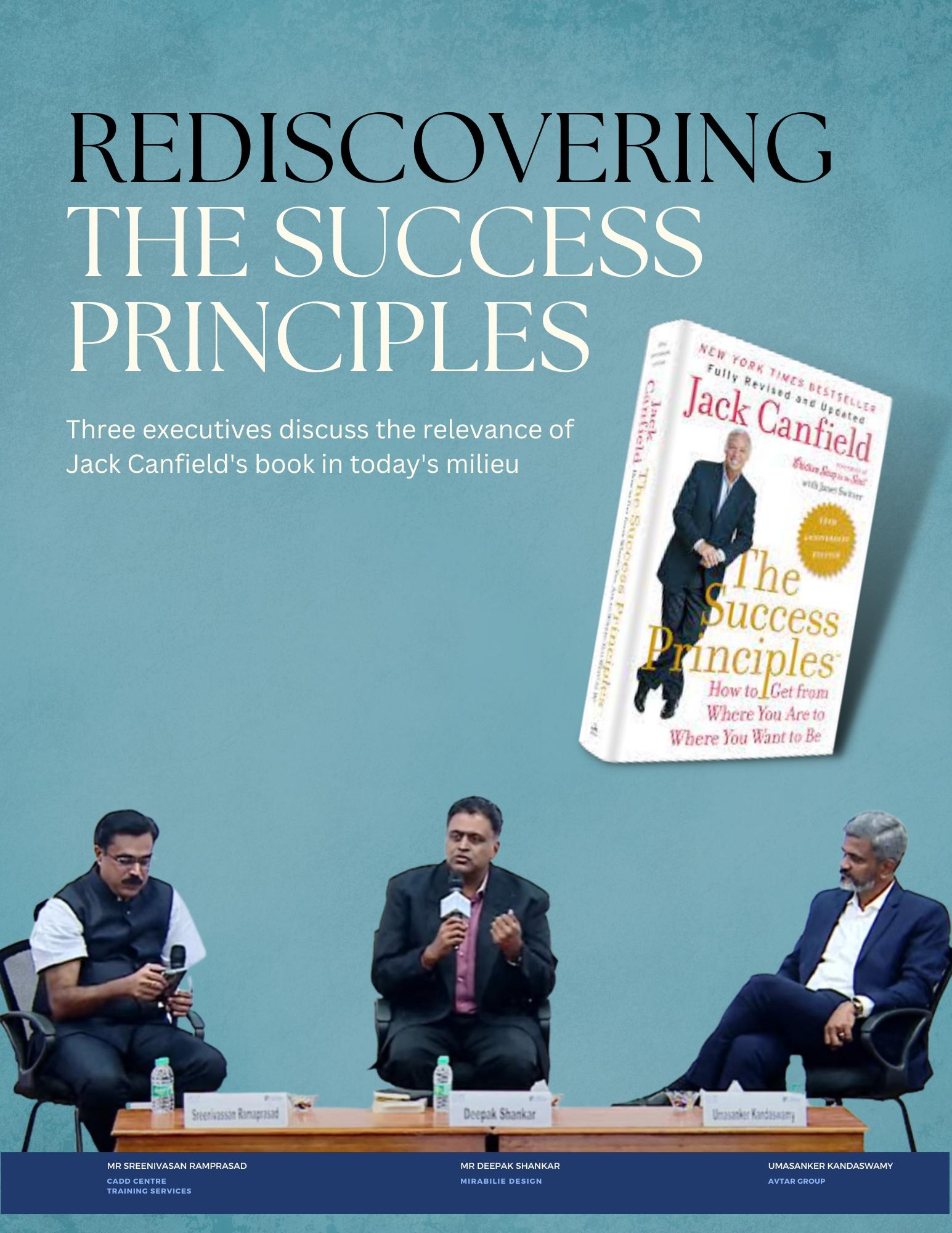
Under the series ‘Read & Grow,’ MMA organised a panel discussion on the theme of the book “The Success Principles: How to Get from Where You Are to Where You Want to Be" authored by Jack Canfield Mr Sreenivasan Ramprasad, Director, CADD Centre Training Services, led the conversation with Mr Umasanker Kandaswamy, Co Founder & Senior Vice President Sales & Relationships, AVTAR Group and Mr Deepak Shankar, Founder & CEO, Mirabilie Design
Ramprasad: Let me begin with some of the key takeaways from the book. If you want to be successful in life, you have to take 100% responsibility You have to be clear about what you want. Your purpose should be well defined. For example, in CADD Centre, we enable the students to realise their dreams by providing them with world class training That is our purpose We have control over only three things in our life: The thoughts we think, the images we visualize and the actions we take. If we manage these three things effectively, we can achieve whatever we want. In the book, ‘Think and Grow Rich,' Napoleon Hill says that whatever the mind conceives and believes, it can achieve Complaining is an ineffective response to an event and does not produce a better outcome. We must learn to replace complaining with making requests and taking actions which will help us achieve our desired outcomes Think what you can do differently to make it happen
Make a list of thirty things you want to do before you die. Most of the professionals who want to be
successful don't know what they want. If you want to create a balanced and successful life, your vision needs to include the following seven areas: work and career; finances; recreation; health and fitness; relationships; personal goals and contribution to the larger community. The world pays you for what you do. Overcome your limiting beliefs These are some of the points highlighted in the book.
Mr. Deepak Shankar: It talks about an equation: Event + Response = Output. It also says, 'Plan your day the previous night, not on the same morning ' I have found this very useful. When we start planning, we
think
Make a list of thirty things you want to do before you die. Most of the professionals who want to be successful don't know what they want.
~ Mr Ramprasad
about the things that will happen in the future Based on that, we can respond to those scenarios.
Mr. Umasanker: We are all craving for success. First, we must believe that we are all successful There is no one formula to be successful According to me, it is a continuous process. You need to work on it again and again, follow some of the successful people and see they have done for themselves It's all about consistency.
Mr. Ramprasad: I recall a story from a Wayne Dyer's book. A person steps out of his house when it is dark. His key falls down and he searches for the key in the dark. Unable to find it, he goes inside his house where there is light. When asked why he is searching inside the house when he knows for sure that he has lost it outside, he replies, "Because there is light inside " For most problems, we don't look at inside of us but outside.
Mr. Umasanker: Being persistent and purposeful are very important We started Avatar way back in 2000
Being persistent and purposeful are very important. We started Avatar way back in 2000. It's about 22 years that we have been running this organisation.
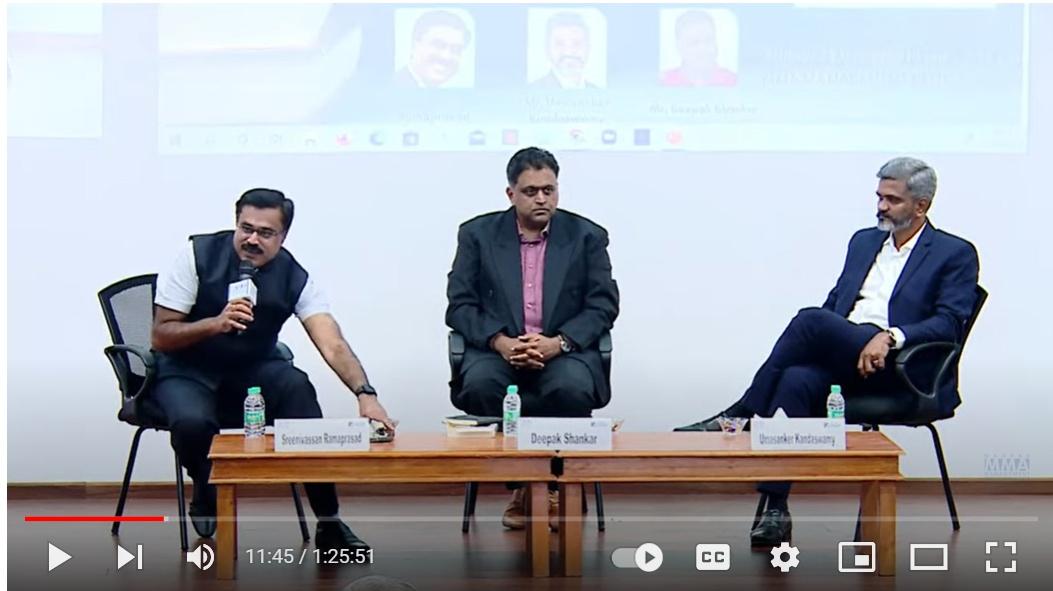 Mr. Umasanker
Mr. Umasanker
~
It's about 22 years that we have been running this organisation We started off with recruitment as our objective. But there were so many people out there and we thought how we could be different. We decided to take up talent which is niche and wanted to empower them We looked at women who were taking a break in their career for maternity or for other social responsibility. When they come back after the break, they are not treated well We wanted to place such women. Two decades ago, when we approached organisations, they were not ready for this idea and we always returned empty handed But we kept on
Without orders in the initial days, paying massive mortgage, travel and other bills was very challenging. But we still stuck on to our goal.
~
Mr. Deepakpersisting because we had a strong purpose.
After five to six years, one company Thomson Reuters decided to give it a try. They hired one woman from us After that, we were able to touch upon a large multinational bank Standard Chartered Bank. They asked us if we could place people for their 125 seater office We took it as a challenge and the entire team worked on it We placed 250 women 125 women worked for half a day with half the salary and the other 125 worked for the rest of the day. It was a win win for us and the company that engaged our people
So far, we have placed 100,000 second career women. For the next five years, we have kept a 5x target for our sales team that is, to help five lakh women. Now we are impacting about 2,000 organisations across India We want to impact one lakh organizations in the next five years. We know it's a very audacious goal. Simply put, there are about 1.5 million women who have taken a break in career Give them at least Rs 20,000 salary to all these women. In the next one month, India will become a superpower. This is possible Our vision is to make sure that in India we have 50/50 gender balance
Mr. Deepak: My Company is US based. Our story of persistence is similar to this. Maybe we don't impact lakhs of people We have a much smaller and focussed business When we started the company in the US, we
were just three of us We sat around a dining table and wanted to start an innovative product company We didn’t want to be a services company. But at that point, US was heading into a recession. Nobody wanted to buy a product from an unknown company We were getting a lot of lucrative consulting engagements but we turned them down.
Finally, after a lot of struggle, we got a call from Vikram Sarabhai Space Centre in Trivandrum They wanted us to do an analysis of the Chandrayaan 1 and find out the likelihood of that rocket failing. We had built a tool for that. Because we waited all the time, we ended up getting a chance to be a pure product company
Then we got offers for the Mars Rover, F16 flight and a whole bunch of other stuff. But those initial days of being focused and sticking to our goal to be a product company, really helped us We live in an extremely high priced neighbourhood in San Francisco. Without orders in the initial days, paying massive mortgage, travel and other bills was very challenging But we still stuck on to our goal.
Mr. Ramprasad: When I started my career with CADD Centre, it was a small organisation. Today we have about 700 centers in 28 countries and every three minutes, a CADD trained person is coming out of a centre. But when I joined, we had only two branches Chennai and Bangalore I joined them in Bangalore and I was just 23 years old Since I was from BITS Pilani and I lived in Delhi, almost every day, I was pushing my boss, who is the current chairman of the company, that we should open a branch in Delhi and that we should be a national company, not just a Madras based company. These two branches together were just making Rs.7 lakhs per annum, which just covered our expenses My boss wanted to put an end to my
pestering So he said, "Okay, I'll agree for the Delhi branch on one condition The first month you go to Delhi, you should bill for one lakh.” He was very confident that it won't happen. Technically, it was possible We were charging Rs 2,000 per student If we train 12 to 13 students every week, we can bill 25,000 per week. But practically, it was not easy, as we would be new to the place and to establish, it would take time
It was 1st October 1990 From that time onwards, I started visualising our Delhi Branch as though we were already operating there. Exactly 25 days later, on October 25th, I got a call from BHEL in Delhi asking us to train 13 engineers at their office in Delhi by sending one of our engineers. So even before I went to Delhi, we got our first order for Rs.26,000 and it was amazing
On 5 November, I landed in Delhi travelling by Tamilnadu Express. Agitations due to the Mandal Commission report were going on and I somehow managed my way to my house I had very limited time I had to do another 74,000 to meet my target. Engineers India Limited came to my mind because they are all engineers creating big refineries and other projects I went to their office
I was in their first floor of their office waiting to meet the person responsible for CAD. I was sitting outside his cabin and I heard a dialogue from inside Two people were talking The first person said that they had completed their supplies of hardware and software and requested for acceptance. The second person said, "You have supplied hardware and software but you need to complete the training " Then the first person said that they would complete the training before the installation and requested the other to sign the acceptance The second person said that it was very
f o u n t a i n h e a d o f
~ Mr. Ramprasadclearly written in the contract that only after the training was completed, they would be able to release the payment " The first person continued, "If it was ordinary training, we would have done immediately but this is CAD training."
Hearing this, I could not resist myself. I walked into the cabin and said, "I'm sorry gentlemen I overheard your dialogue. I am from CADD Centre and I heard that you were talking about CAD Training. I can help you. " I discovered that the first person was from HCL and he was a senior in my college Guess what happened? Within the next half an hour, he took out a letterhead from his suitcase and issued an order for CAD training of 28 people, starting from November 19 of the same month So I got an order for Rs 56,000 I was acting pricey and asked for advance payment because I knew he was desperate. The same evening, he gave me the advance Now Rs 82,000 was in my kitty
Two days later, I went to another company to explore the training opportunity. They said that they didn't need training but wanted the CAD software. I said, "I can manage that " I knew HCL supplied the software. We were not allowed to sell software at that time. So I took a special permission, supplied the software for Rs 25,000 and exceeded my target by Rs 7,000 That's how we started our Delhi branch The lesson here is, if you passionately want things to
Start visualizing what you want to be. Don't keep it just as a wish. The universe will work for you.
happen, it will happen Start visualizing what you want to be Don't keep it just as a wish The universe will work for you. Now, my question is, are the success habits given in the book still relevant today?
Mr Umasanker: They are all very much relevant The basic principles will stay forever
Mr. Deepak: The principles are the same but they have evolved. For example, many of the work can now be done very quickly as we have many online planning tools Many of them are available for free
Mr. Ramprasad: How much applicable are these success habits for Gen Z?
Mr. Umasanker: Gen Z relies heavily on Google as a teacher Going forward, information and data is power Attrition is a major problem now. About 40 to 45 percent of the people offered a job, do not take the offer and so much of effort is getting wasted We have created an artificial intelligence tool to predict if a person will take the offer or not.
In the younger generation, we have two types. One who are born with a golden spoon and the other, who don’t even have a spoon We are a research organisation. We have a trust called Avtar Human Capital Trust and studied the percentage of girls who pass out from corporation schools run by the government and join the college. It is just 1%. We have
created a project called ‘Project Puthri ’
This project is the brain child of Dr Saundarya Rajesh, our founder. We have 500 volunteers. We go to all the schools, sign up and conduct a training program for students of 8th to 12th standards 40 skills are imparted to them over five years Through this, we are impacting about 7,000 children.
Most children come to these schools to have food, to use the bathroom and then for education which is only third on the order of priority We want to change this and we have taken it as a mantle upon us. Many corporates are helping us in this project. India needs to become a developed country and our girls are going to take India to the next level. As a country, we are lax in following the processes. If we follow the processes and if we are persistent, we can achieve our goals
Mr Deepak: Today, it’s no longer about financial success as most people have a baseline. Processing information around us and evaluating it is very important Garbage in comes on WhatsApp University but you can’t have garbage out The challenge for Gen Z is that they have too much information. They need to narrow down. My daughter has chosen podcast as a medium to communicate She interviews kids from across the world How did she narrow down to this choice? She did a lot of research. I am happy to share that her podcast is ranked No 2 in the world in the category of ‘podcast for teenagers ’
Mr Umasanker: Just a few words for Gen Z Whatever input goes into the mind will determine the output. Be conscious of that. Life is very simple. Don't complicate it You may have many online friends But when the Internet is down, they will all disappear. Make sure you are physically and mentally connected with people, apart from connection through the internet
f o u n t a i n h e a d o f e x c e l l
If we follow the processes and if we are persistent, we can achieve our goals.
~ Mr. Umasanker
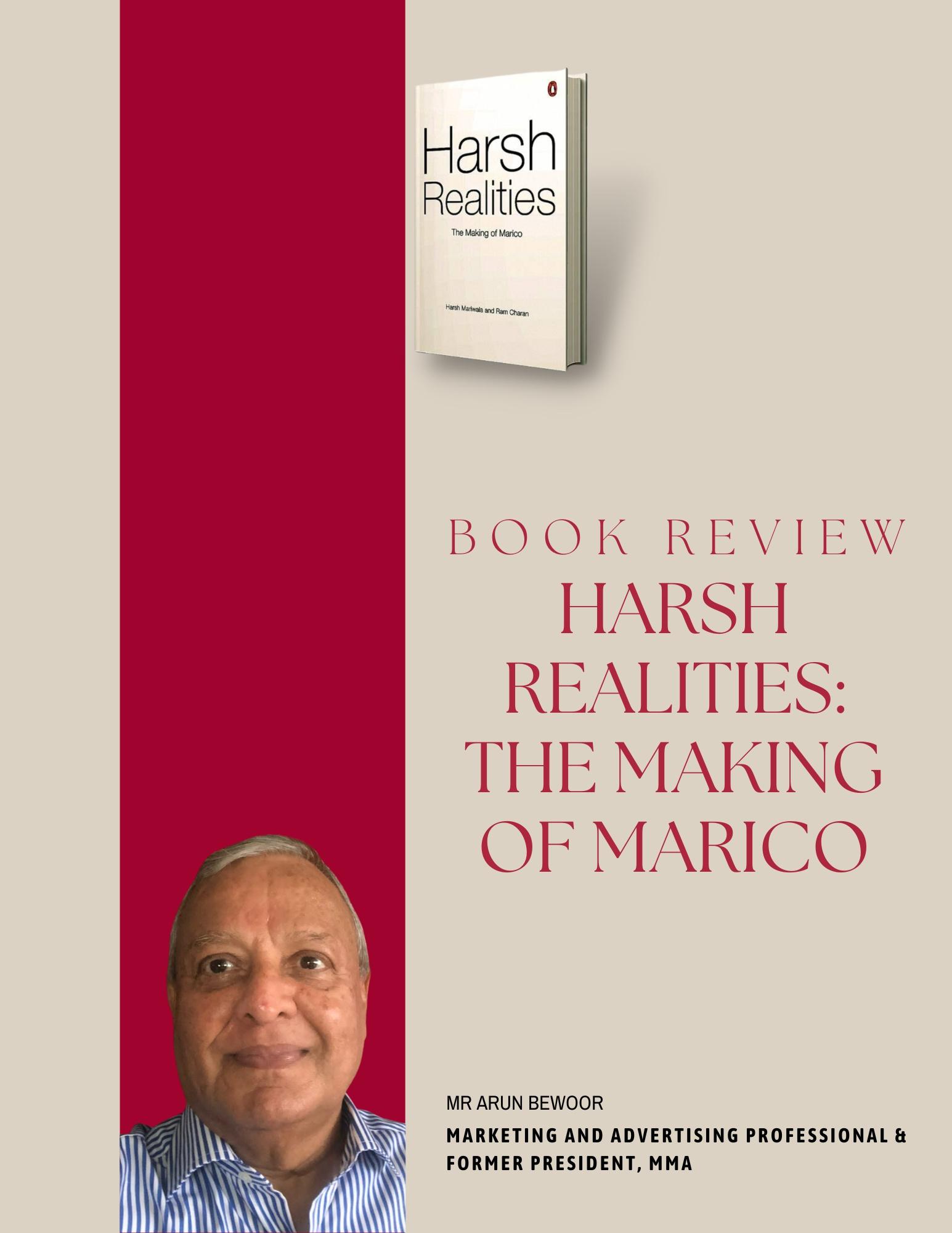
Harsh Mariwala's book Harsh Realities was a highly anticipated Indian business story of one of the biggest FMCG conglomerates in the world
Mr. Arun Bewoor, a marketing and advertising professional and a former president of MMA, digs deep into the book and shares his insight on some of the points touched by the narrative
ARUN BEWOORWhen the Philadelphia Mayor unveils the statue of Rocky Balboa in the eponymous movie Rocky III, he says: “Every once in a while, a person comes along who despite the odds defies logic and fulfils an incredible dream Touched by your accomplishments we today celebrate the indomitable spirit of Man.”
Was Harsh Mariwala a similar maverick in a similar situation when he decided to enter the tough, competitive FMCG market in the country? Unlike the boxer who needs only his gloved fists and strong legs to win a match, Mr Mariwala realised, to compete in the
arena, he would need a team of experts who could help in the challenges ahead He quotes Steve Jobs: “Great things in business are never done by one person. They are done by a team of people.”
One of the interesting chapters (no 8) in the book relates to the hunt to recruit talent. There could be no compromises or any shortcuts The chapter delineates the search and quest for managers with multi disciplined skills and who shared his vision. At the best of times, a family owned company based in Masjid Bunder in Bombay was not an attractive inducement. But Harsh Mariwala was obviously good at sharing the revelation of what he had seen and planned for Marico. Here, he elaborates to the
identified candidates that it was an opportunity to not just perform on a portfolio offered but to build an enterprise and create an institution for posterity. He obviously succeeded in transferring his dreams to the persons selected for critical functions of Marico. They served the company with rigour and energy and certainly laid the bedrock for how the firm evolved over the next three plus decades. He accesses external sources where needed and also acknowledges the unstinted support he received from his paternal uncle (Kishore Mariwala), who possibly envisioned that Marico could develop into a branded FMCG firm to compete with the best. Later in the volume there is a certain poignancy as some of these stalwarts appreciate that
Marico has outgrown them and they may have outreached it in turn. They exit with dignity, satisfaction and pride at what they leave behind This is where Harsh Mariwala displays nerve and faith to execute what he proclaimed.
Bill Gates (Microsoft) once said: “One of the most difficult tasks for an entrepreneur is to have the confidence (or is it courage?) to ‘let go’ ” Not just step back from Operational Management but to literally and figuratively hand over the reins to professional managers. No primogeniture succession, no looking over the shoulder, no ‘continuous’ meetings to review progress. Despite reluctance from family and protests from well wishers, Harsh did ‘Let go’ a rare occurrence at the best of times. And his gamble, as this story unfolds, has paid off Competent and capable executives took charge and have more than met the standards that Mr Mariwala set for himself and them The book inevitably starts with the wrenching decision to break away from an established, recognised family business in commodities and do what all companies desire but not always have the wherewithal to actually do: Add Value. Internecine battles followed with endless meetings and
negotiations to reach an acceptable decision to satisfy all components. Persistence was the key, and it succeeded Mr Mariwala was the Captain of his boat, the sails of Marico were unfolded to catch the wind The journey had started.
The buying of the key raw material (Coconut Oil) had been built through a reliable relationship on quality, price and export. The inefficient and lengthy distribution chain was shortened, eliminating intermediaries and offering a better value to the Farmer. One brand (Parachute) was already well recognised by consumers to represent a level of quality. That emotion needed to be reinforced and spread Marico’s coconut oil could not and should not be considered a commodity. At the start, as expected, funds were a serious barrier Borrowing was not easy. But again, resilience mattered. The reputation and stature of the Mariwala clan helped while negotiating with lenders. Uday Kotak turned out to be a white knight This was critical with Marico’s IPO It allowed investment and spending on a scale that otherwise would have cramped
expansion and resulted in moribund and inadequate efforts.
Building the brands Parachute and Saffola (Cooking Oil) was a challenge in a market with tough competition from strong players. And here is where Marico scored with innovation, strategic thinking, use of technology, deep consumer understanding, creative advertising, wider and deeper distribution, making allies with the trade and something as simple (and yet revolutionary) as packaging Altering the shape of the final pack for easier stacking, using pilfer proof caps and having better graphics made an impact on the cooking oils market on a scale not witnessed before. And as any corporation realises the daring to remain ahead is continuous no
The book inevitably starts with the wrenching decision to break away from an established, recognised family business in commodities and do what all companies desire but not always have the wherewithal to actually do: Add Value.
marking time, no pause With success, other brands followed Sweekar (later discontinued) was launched on a price platform. More significant was the diversified portfolio into hair care, fabric care. The food business (an undoubtedly difficult market to battle in) was entered through cereals Skincare was more elaborate with Kaya clinics specialising in complexion, hair removal, enhancing beauty This was a first for Marico in a Direct to Consumer business. The participation in the market via a broader product range with decreased dependence on one or two categories, marketing became more robust as seasonal variations were ironed out
M&As to accelerate growth followed with focus on similar product lines and geographies, with expertise more readily available In hindsight, some acquisitions and JVs seem a knee jerk reaction without much forethought Some ended before really fructifying Others succeeded and formed an integral component of the Marico universe
Time gave the perspective and experience provided the maturity for more surer and reliable partners and ventures One theme that streams through the book is about
the set of values which were defined, elaborated, communicated and ingrained into the very soul of the company, which is now rapidly expanding with new managers, trainees, and technicians on the Board. The values went beyond the vision and strategy. They cut across company departments, budgets and reviews. Rather, they propagated norms of behaviour and practices which are repeated and reinforced
As founder and CEO, Harsh Mariwala felt that the business had to be conducted under certain norms and within a framework that was enunciated in the values An entire chapter (no. 9) is devoted to this subject. What did it mean and how did it impact the manner business was conducted? Values become an almost core competence.
The text right throughout the book is straightforward and candid It reflects the author’s profile of humility to the point of self effacement. The influence of Ram Charan (co author and Harsh Mariwala’s guru) is obvious. Events of importance, milestone markers, decisive times, inflexion points are written without drama or histrionics. This reviewer feels some parts could have been spiced up. Particularly the episode on the rather savage call from the Hindustan Lever Chairman
threatening to buy out Marico or else Mr Mariwala makes no dramatic sweep, except displaying restlessness that converts to resolution and defiance How the saga ended with Marico buying the very brand Unilever wanted to leverage (pun intended) is well told and forms part of company lore
Since its founding in 1990, the company’s sales, market cap, and stature have grown leaps and bounds Marico personnel are valued and respected. Marico brands are well known. Awards and recognitions followed Marico is a respected FMCG company in the Indian economy. It is included in relevance and with reverence when business papers comment on Unilever, Nestles, Colgate, Godrej and others.
The book later covers the author’s encouragement to entrepreneurship, a meaningful CSR, the Ascent Foundation, Health Initiatives and others
To quote Ralph Waldo Emerson: An institution is but the lengthened shadow of one man.
So, what next? The vision will set the pace Values will hold the company. Innovation will keep it ahead. The journey continues as it must The road ahead beckons
